Allison Collection Photos
April, 1942
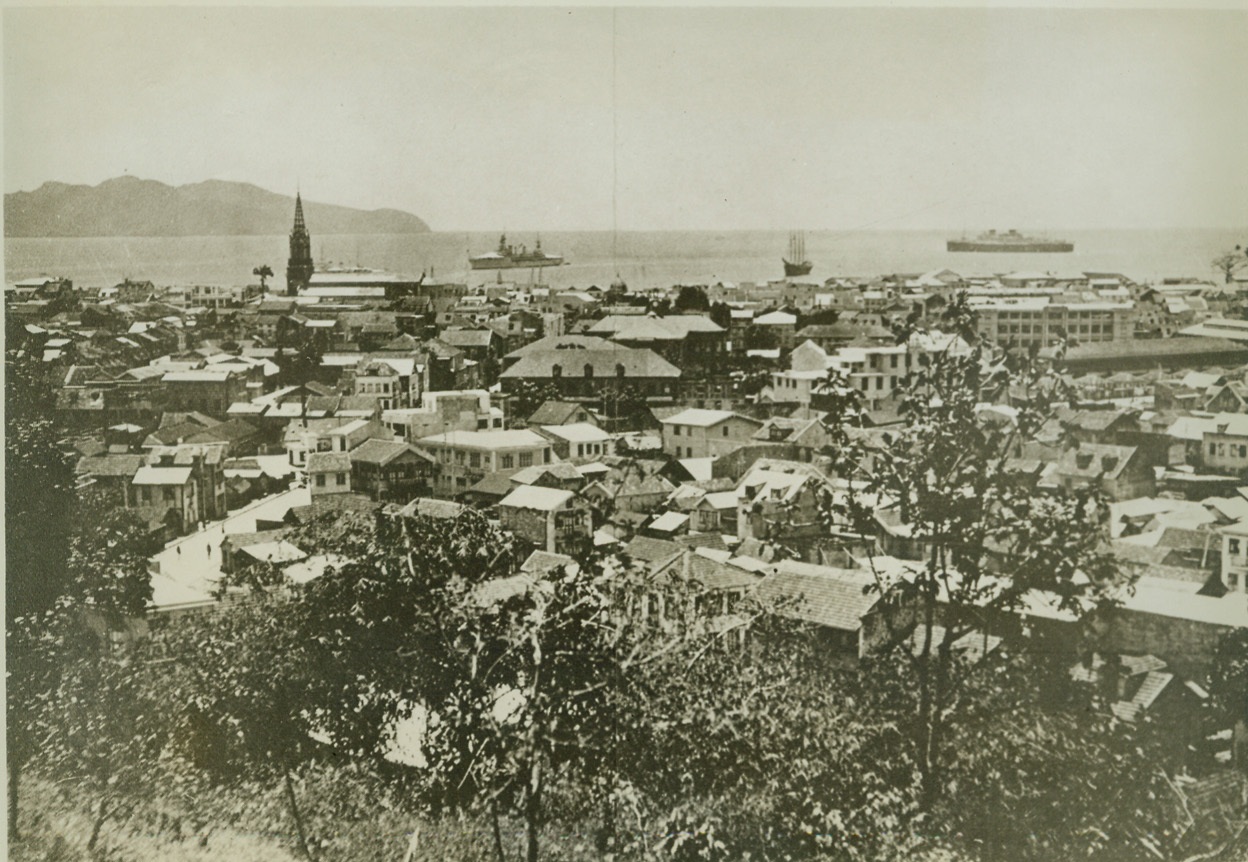
U.S. MAY TAKE OVER FROM VICHY, 4/17/1942. View of the Caribbean Island of Martinique, showing the principal port, Fort-De-France, which the U.S. might take over in the event of severange of relations with Vichy, in order to prevent the island coming under Axis control. Units of the French fleet are now isolated at Fort-De-France. Credit: OWI Radiophoto from ACME;
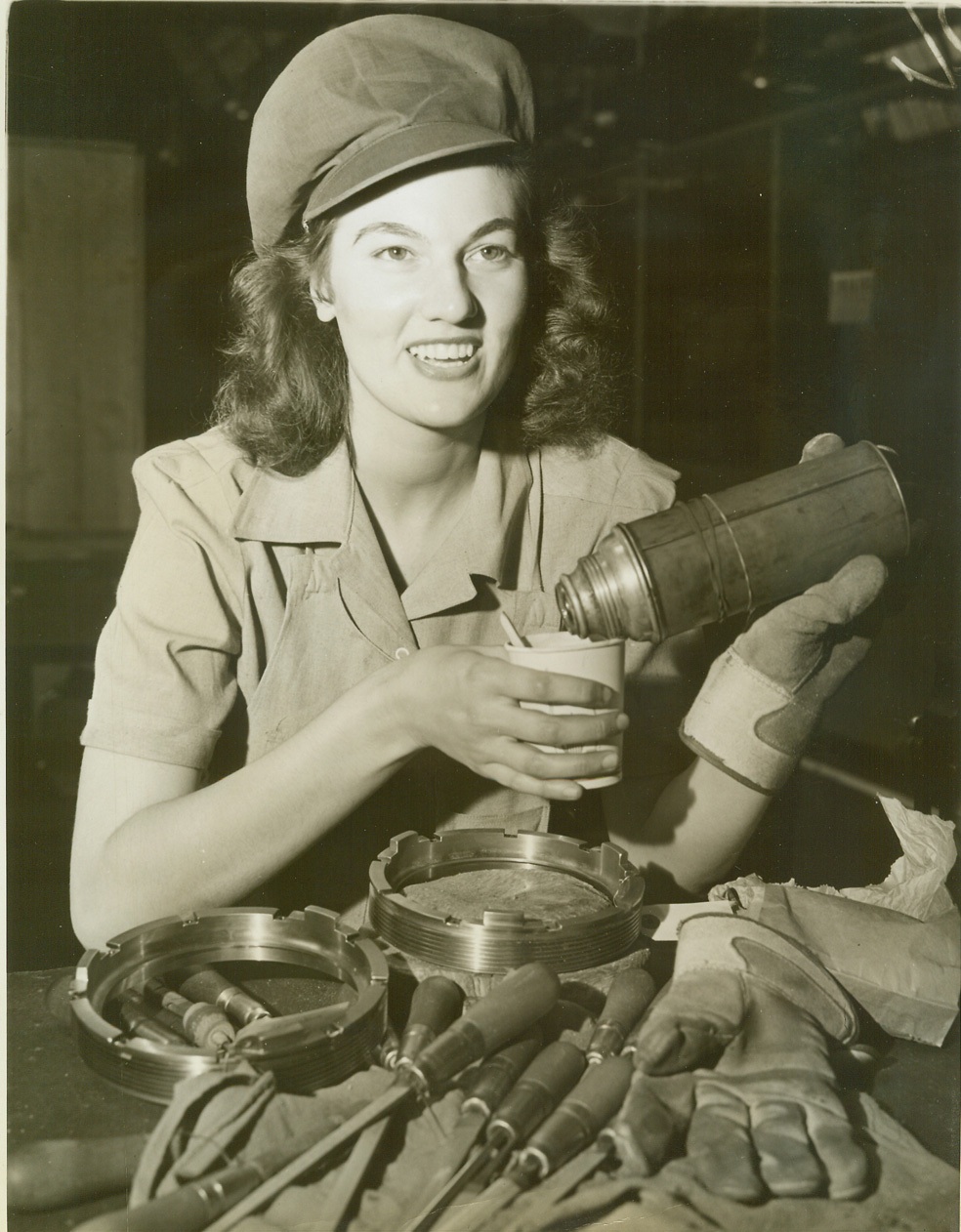
WOMEN ENTER ANOTHER WAR INDUSTRY, 4/17/1943. The women of America are plunging more and more whole-heartedly into America’s tremendous war production effort. With husbands, brothers and sweethearts in the Armed Forces, modern women are doing their patriotic bit in the nation’s factories, as well as in uniformed services. The uniform for them is overalls or slacks, and many have left clean, leisurely office jobs for positions as inspectors, equipment handlers or actual machine jobs. In this New Jersey propeller factory an initial group of 14 women began work Jan. 29, 1942, after a six-weeks vocational school course, and the feminine element is appearing in ever-increasing numbers among workers fashioning the blades that will drive the war planes which will drive the Axis from the skies. This series shows some of the “bladeswomen” at their work. Time out for lunch amid an atmosphere of tools and gloves. A far cry from metropolitan tea rooms many of the workers formerly frequented. Credit: OWI Radiophoto from ACME;
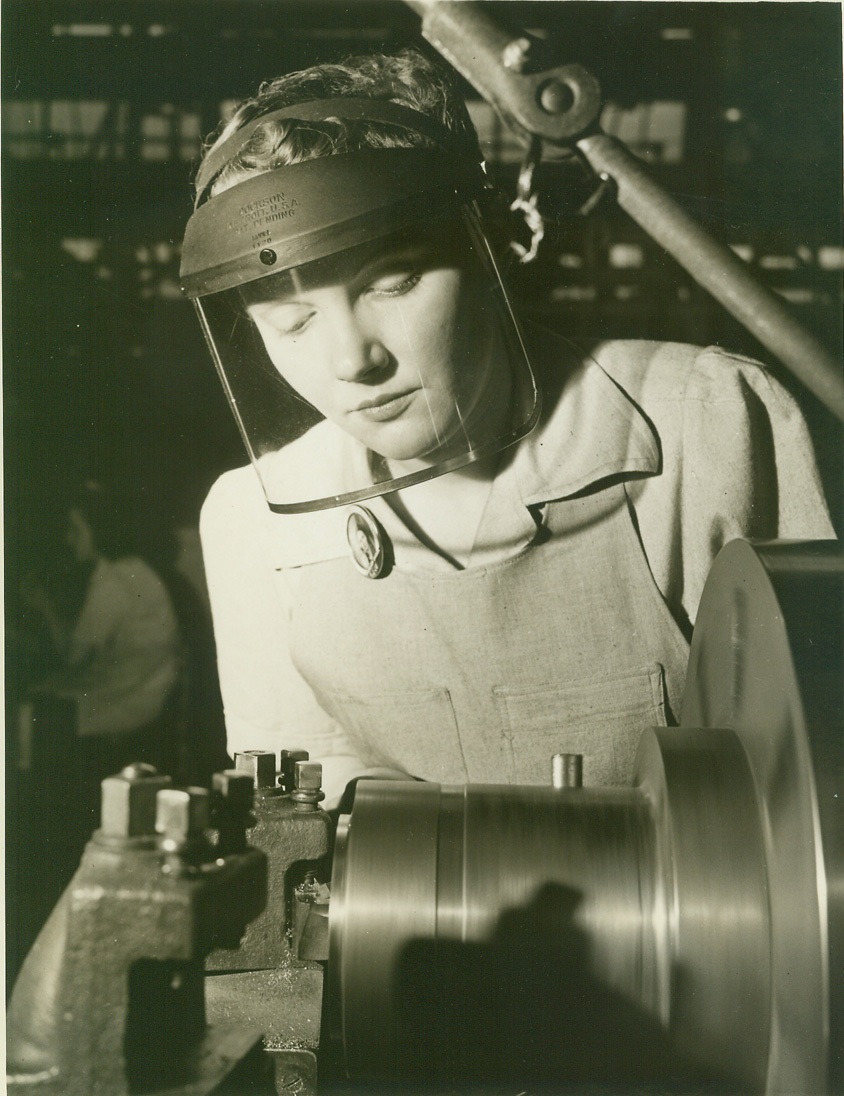
WOMEN ENTER ANOTHER WAR INDUSTRY, 4/17/1942. The women of America are plunging more and more whole-heartedly into America’s tremendous war production effort. With husbands, brothers and sweethearts in the Armed Forces, modern women are doing their patriotic bit in the nation’s factories, as well as in uniformed services. The uniform for them is overalls or slacks, and many have left clean, leisurely office jobs for positions as inspectors, equipment handlers or actual machine jobs. In this New Jersey propeller factory as initial group of 14 women began work Jan. 29, 1942, after a six-weeks vocational school course, and the feminine element is appearing in ever-increasing numbers among workers fashioning the blades that will drive the war planes which will drive the Axis from the skies. This series shows some of the “bladeswomen” at their work. Rose Walker, a married woman who used to be an office worker, now operates a lathe on the nut line. Credit: OWI Radiophoto from ACME;
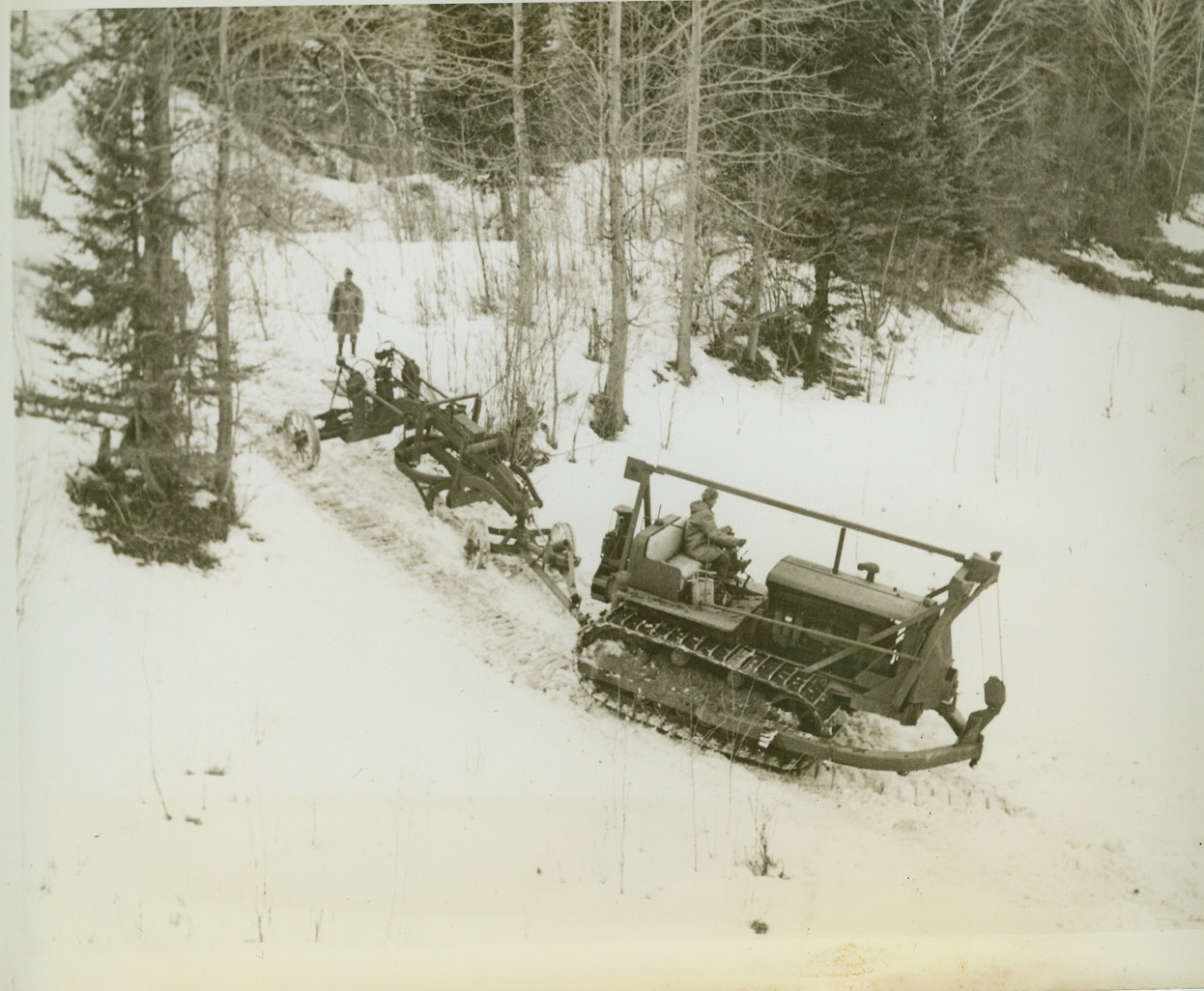
HELPING LAY NEW HIGHWAY TO ALASKA, 4/3/1942. NELSON, B.C.—Highway building equipment bound for an advance point on the new highway from the U.S. to Alaska crosses Cutrank River in isolated British Columbia territory. Credit: OWI Radiophoto from ACME;
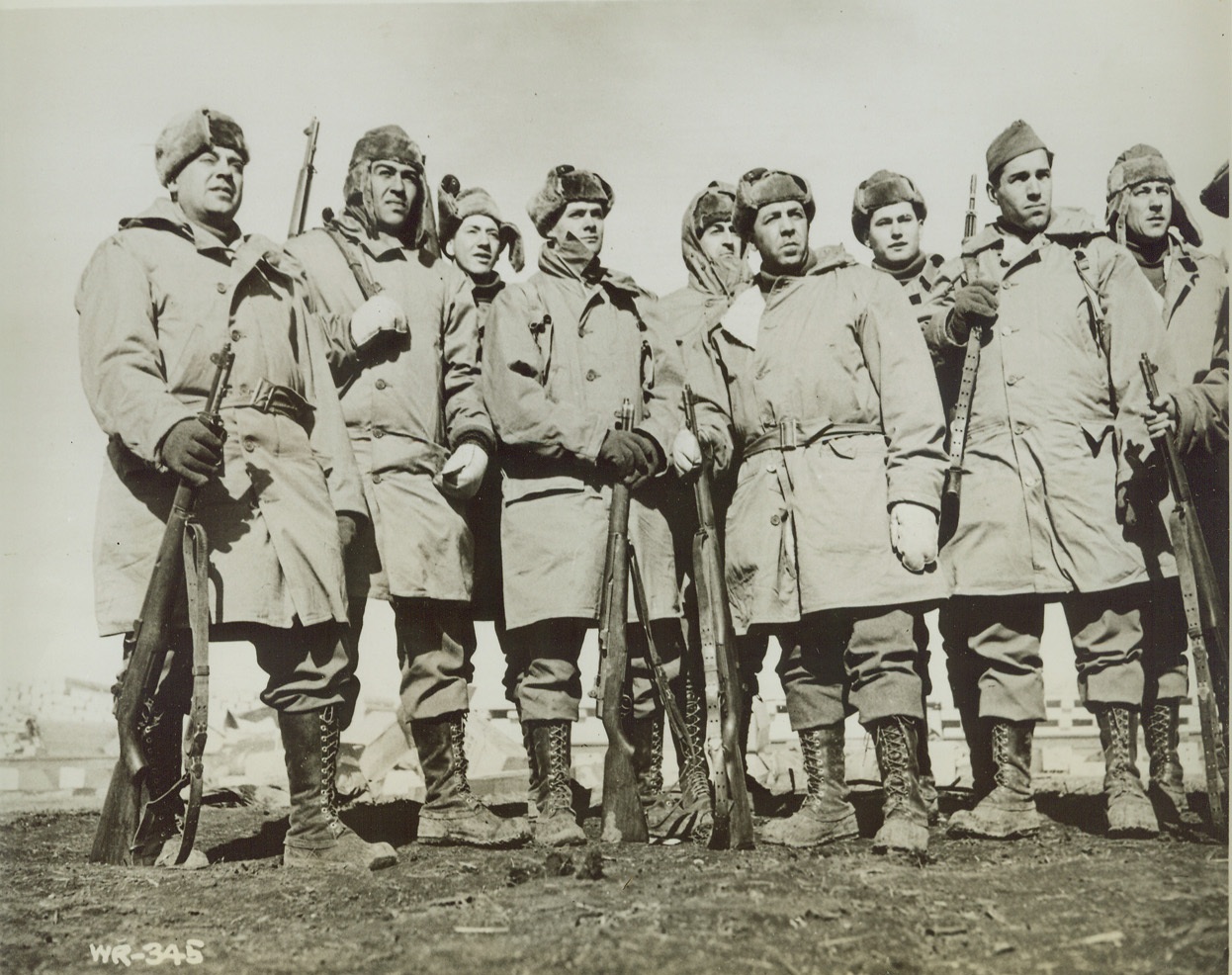
HELPING BUILD ALASKAN HIGHWAY, 4/3/1942. BRITISH COLUMBIA – American fighting men looking remarkably fit and well-fed, are shown on duty on the new U.S. to Alaska Highway. Front row, left to right: Pvt. George Francesconi, Chicago; Pfc. Joe Trevino, Corpus Christi, TX; Pvt. Joe Stack, Buffalo, N.Y.; Pvt. John Viveriot, Buffalo; Pvt. Don Silverthorn, Kenmore, N.Y. Back: Pvt. Henry Geyer, Pittsburgh; Sgt. A. F. Gill, Warrior Run, PA; Pfc. John Sadler, Valley Mills, Tex.; Pvt. W.R. Mullins, Detroit, Tex. Credit: OWI Radiophoto from ACME;
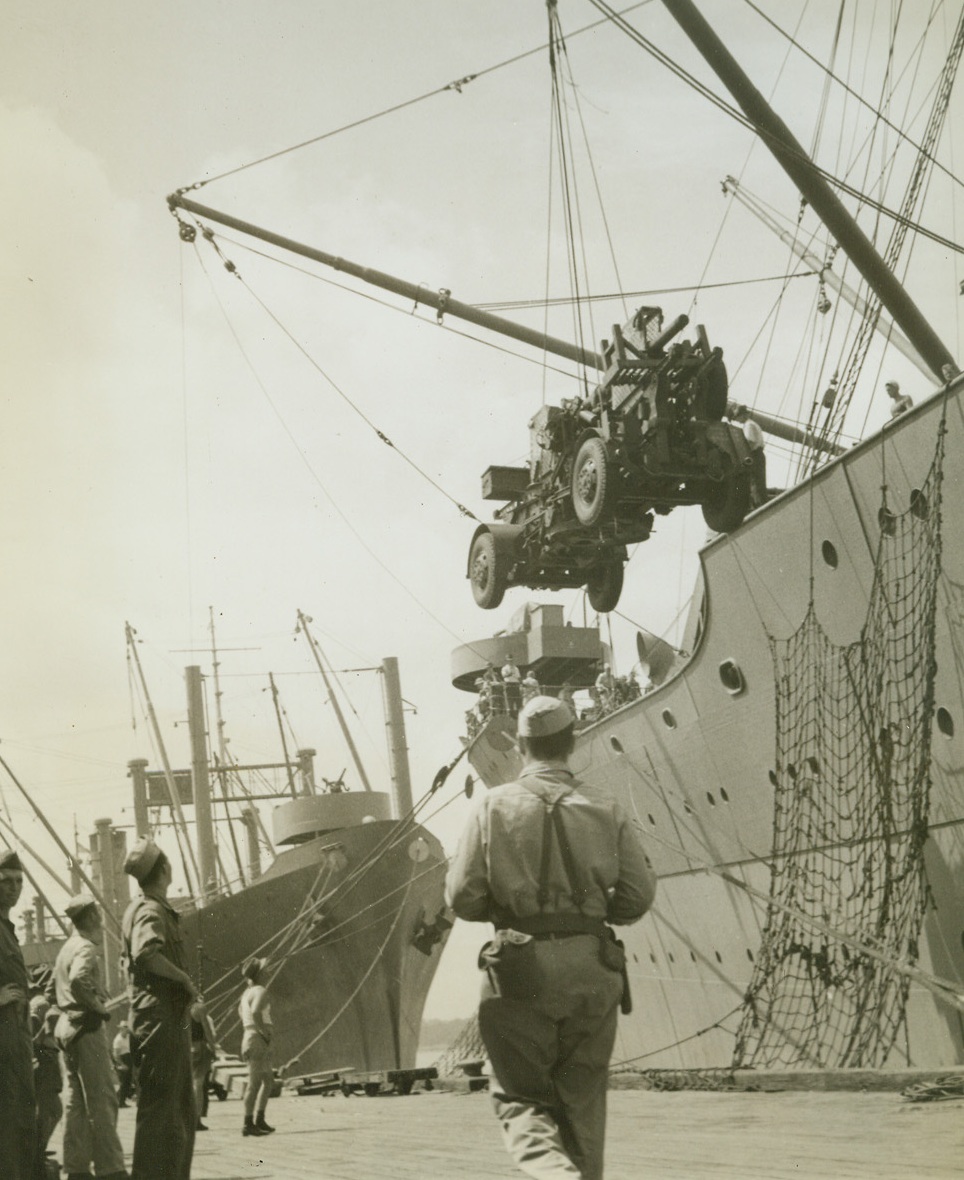
“Ack-Acks” from America, 4/8/1942. Australia – A three-inch anti-aircraft gun is unloaded from a U.S. transport which arrived in an Australian port with troops and supplies from America. Passed by censors. Credit: ACME;
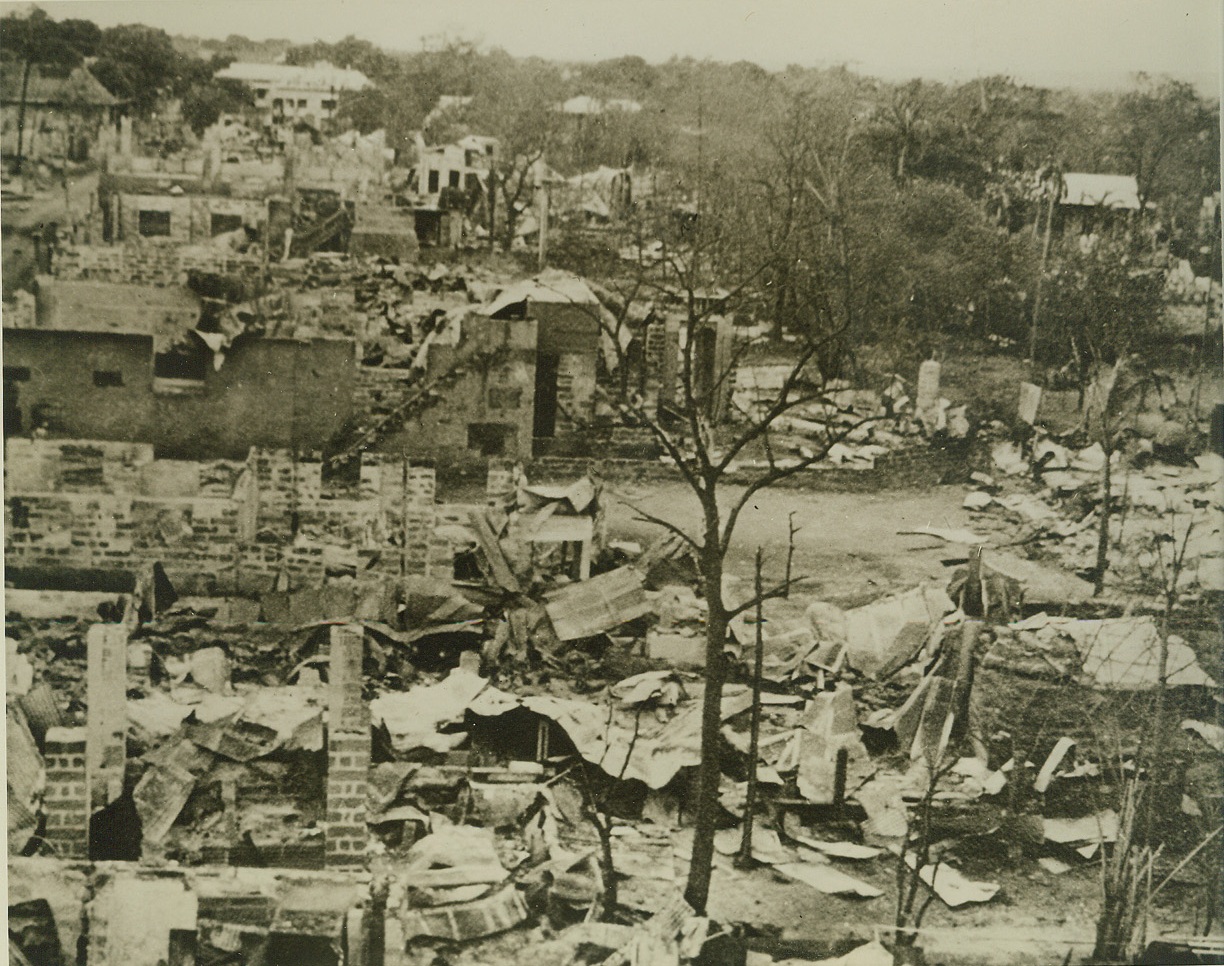
Jap Destruction of Bataan Peninsula Town, 4/9/1942. All that remains of a town on Bataan Peninsula – which is now entirely in Jap hands – after Japanese aerial bombs and shells from heavy siege guns, had completely leveled its houses and structures. This is one of the latest photos to come out of that battle area. Credit: (U.S. Signal Corps Photo from ACME);
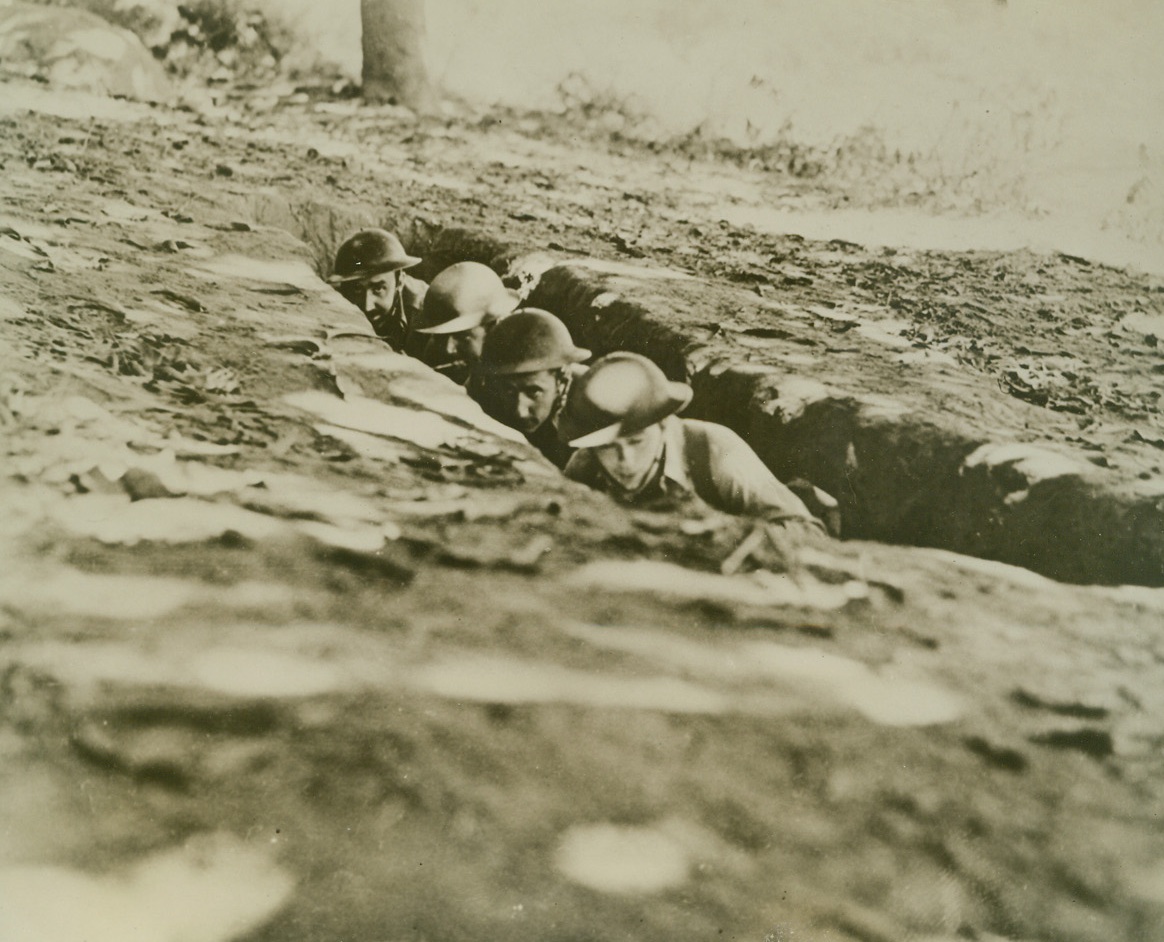
AMERICAN OFFICERS IN BATAAN FOXHOLE, 4/9/1942. This picture, one of the latest to be received from the Bataan Peninsula, now lost to American forces, shows American officers in a foxhole, ducking shrapnel fire from Japanese guns. Left to right, are: Capt. S. O. Little, Sgt. John G. Graham, Lieut. P. W. Frutiger, and Corp. R. L. Carter. Credit: U.S. Army Signal Corps photo from Acme;
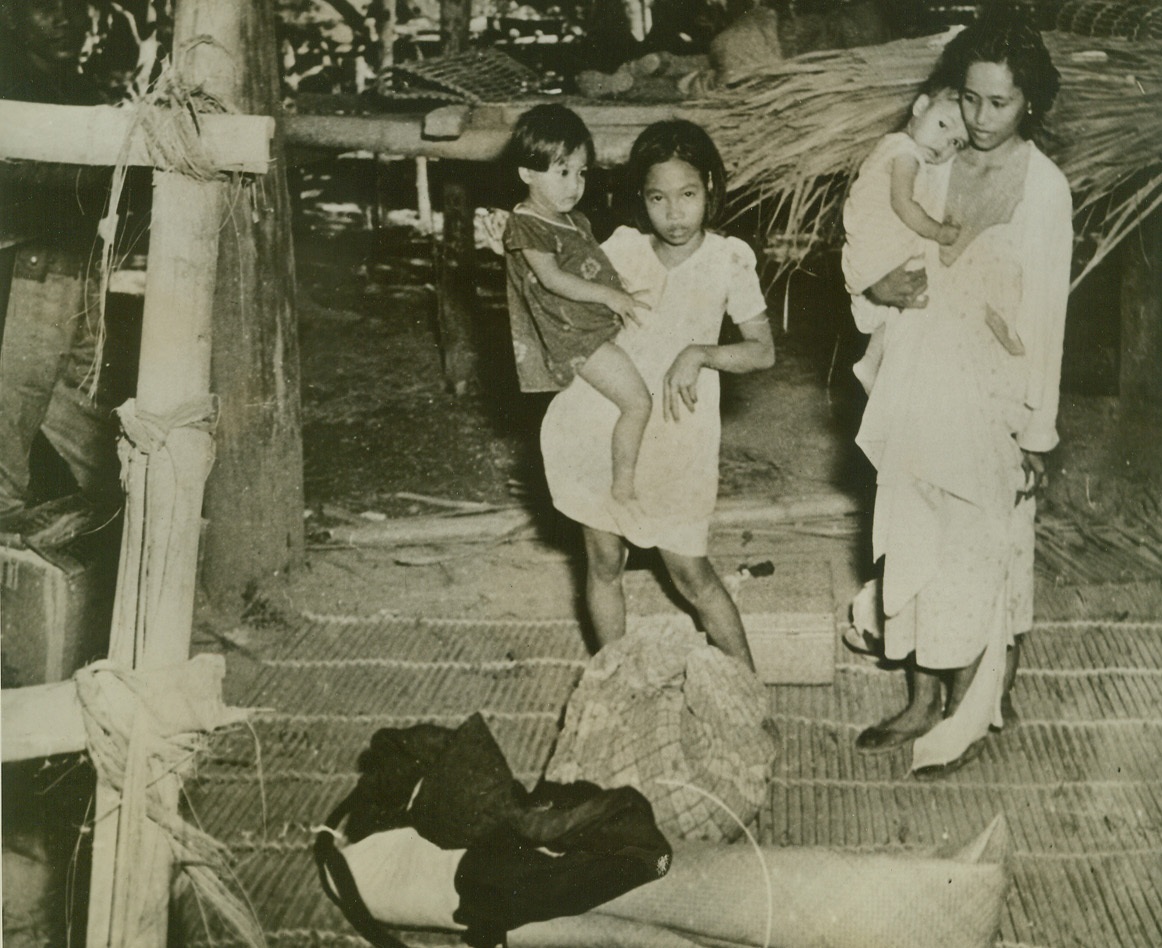
BATAAN PENINSULA REFUGEES, 4/9/1942. This picture, one of the latest to be received from the Bataan Peninsula, shows innocent victims of the war, as they prepared to evacuate their homes, “somewhere in Bataan.” Credit: U.S. Army Signal Corps photo from Acme;
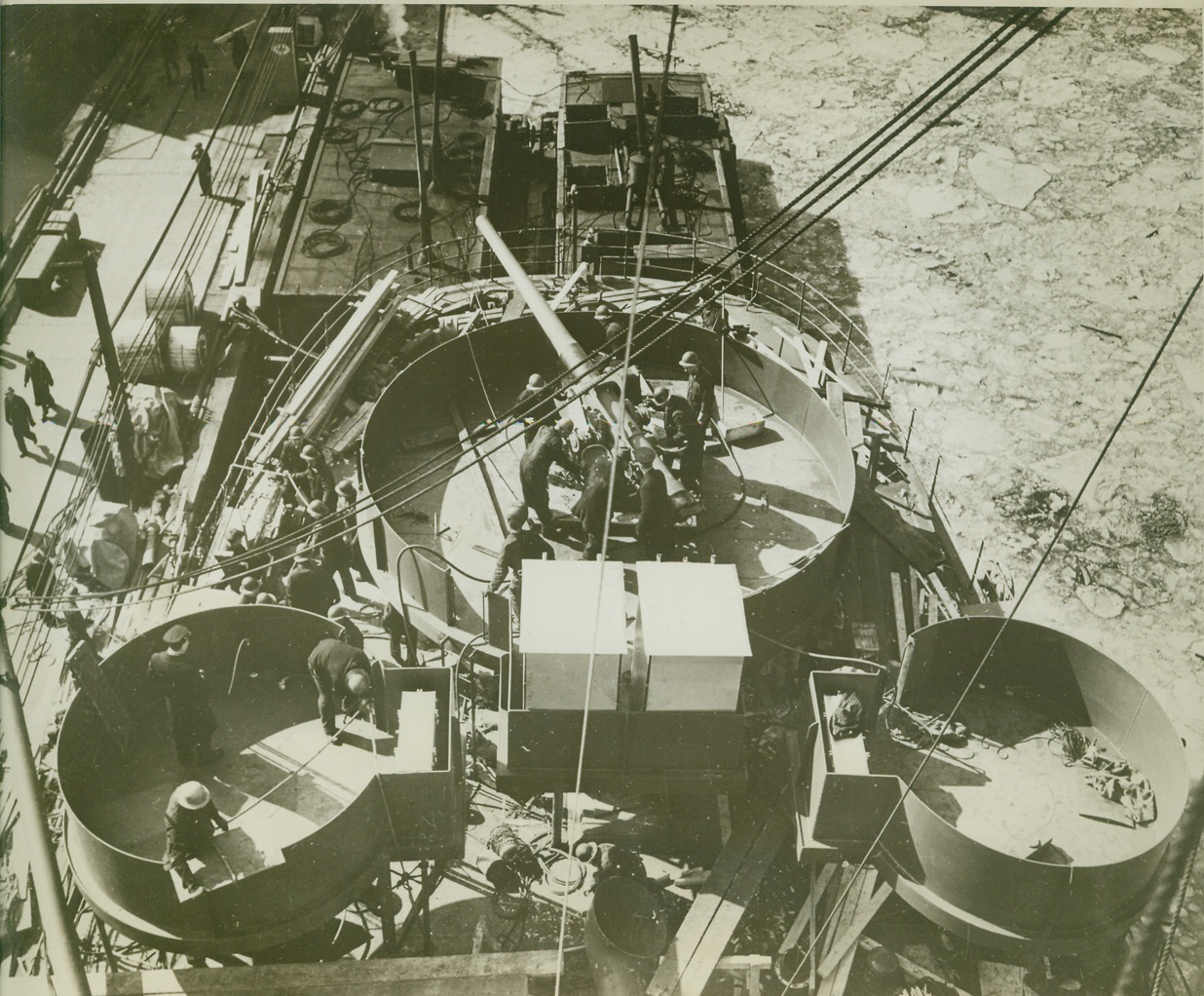
Navy Speeds Army of Merchantmen, 4/9/1942. Workers, shown as they make final mechanical adjustments on a heavy gun, (center), which rests in its steel-protected emplacement aboard a merchantman, in a shipyard “somewhere in the United States.” Credit: Official Navy photo from ACME.;
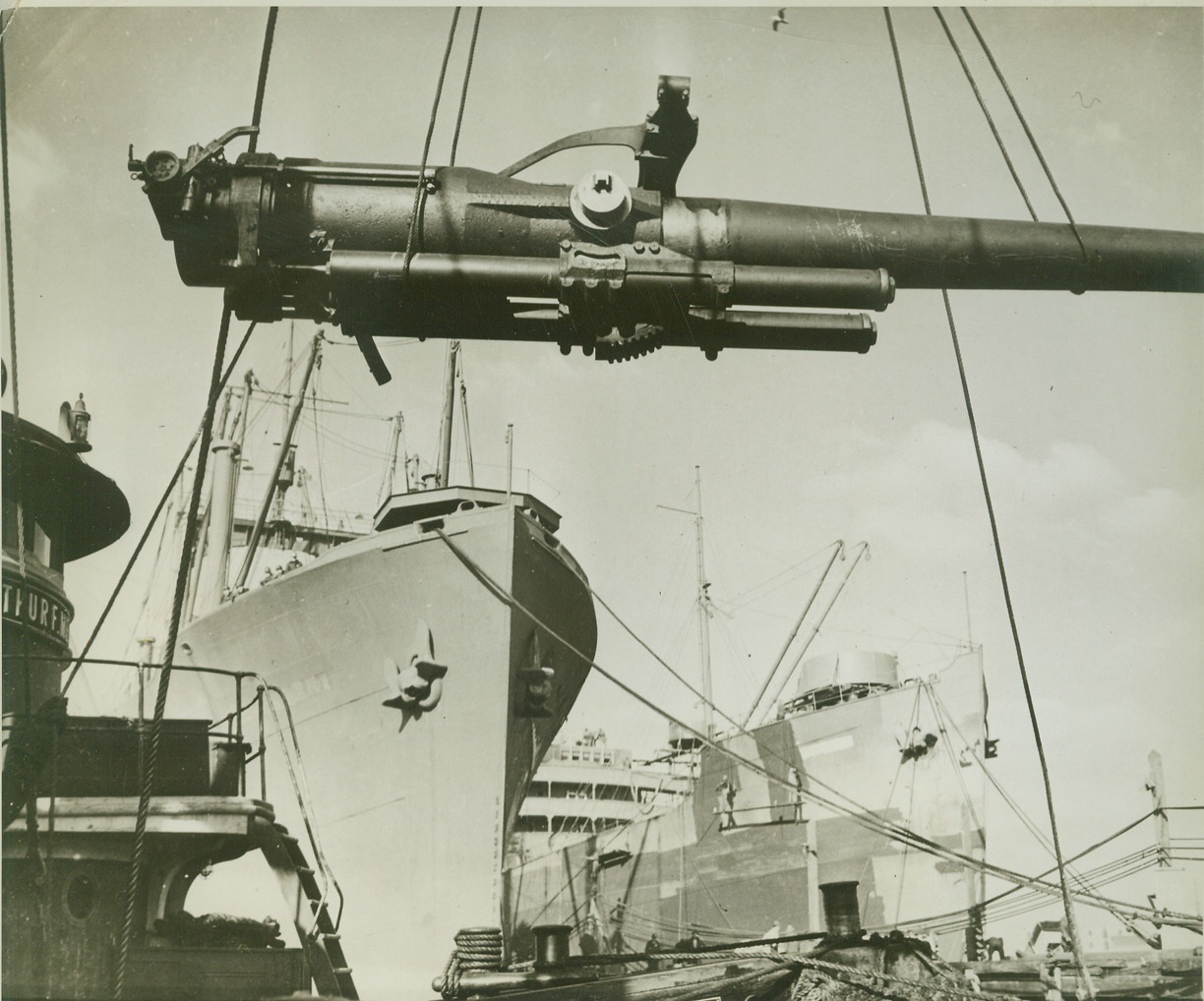
Navy Speeds Arming of Merchantmen, 4/9/1942. Heavy gun, as it is hoisted aboard a merchantman by a powerful crane, in a shipyard “somewhere in the United States.” Credit: Official Navy photo from ACME.;
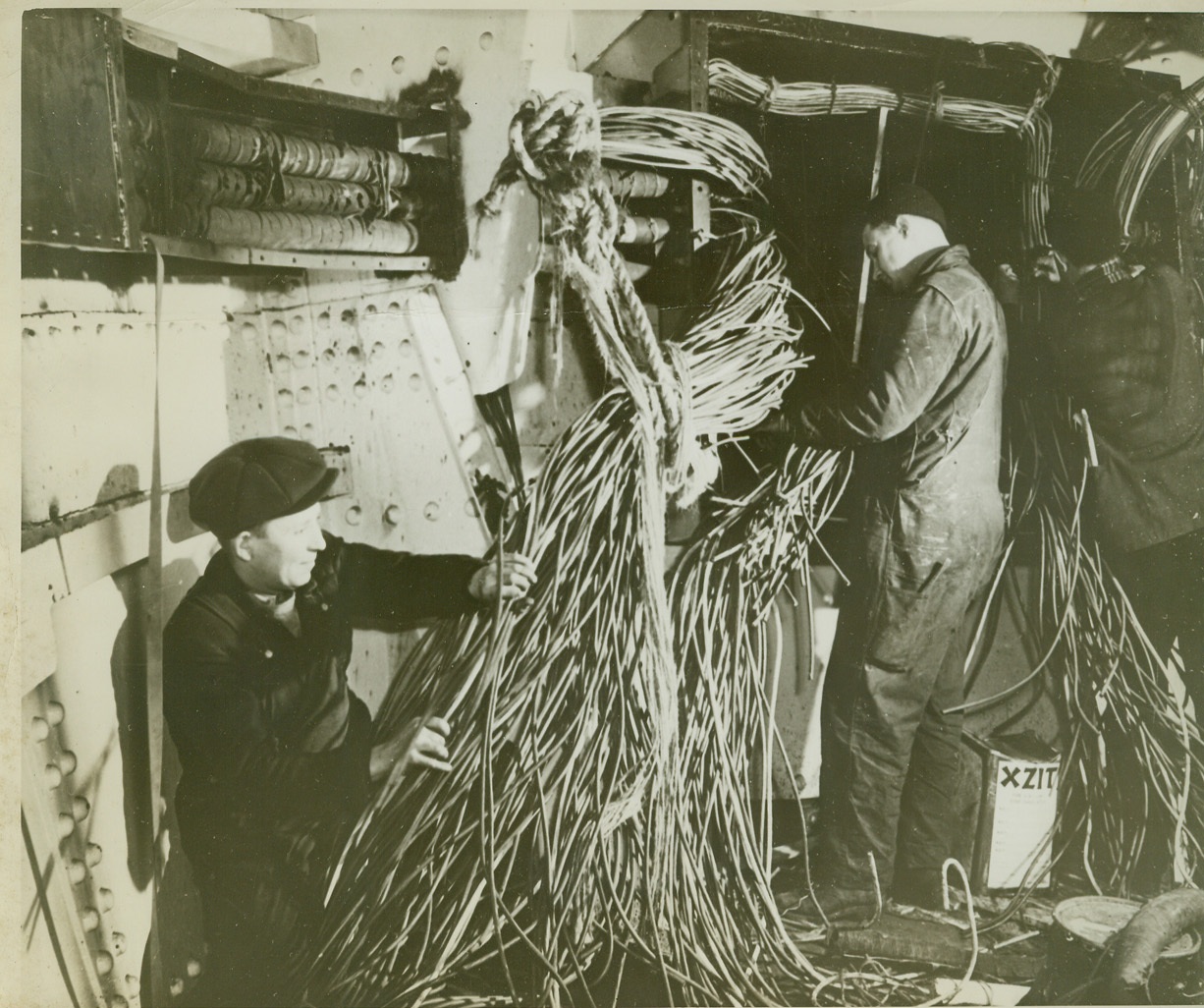
NAVY SPEEDS ARMING OF MERCHANTMEN, 4/9/1942. Shipyard workers, as they installed de-gaussing cables aboard a merchantman, to protect the ship against magnetic mines. Photo taking in shipyard “somewhere in the United States.” Credit: U.S. Navy photo via OWI Radiophoto from ACME;
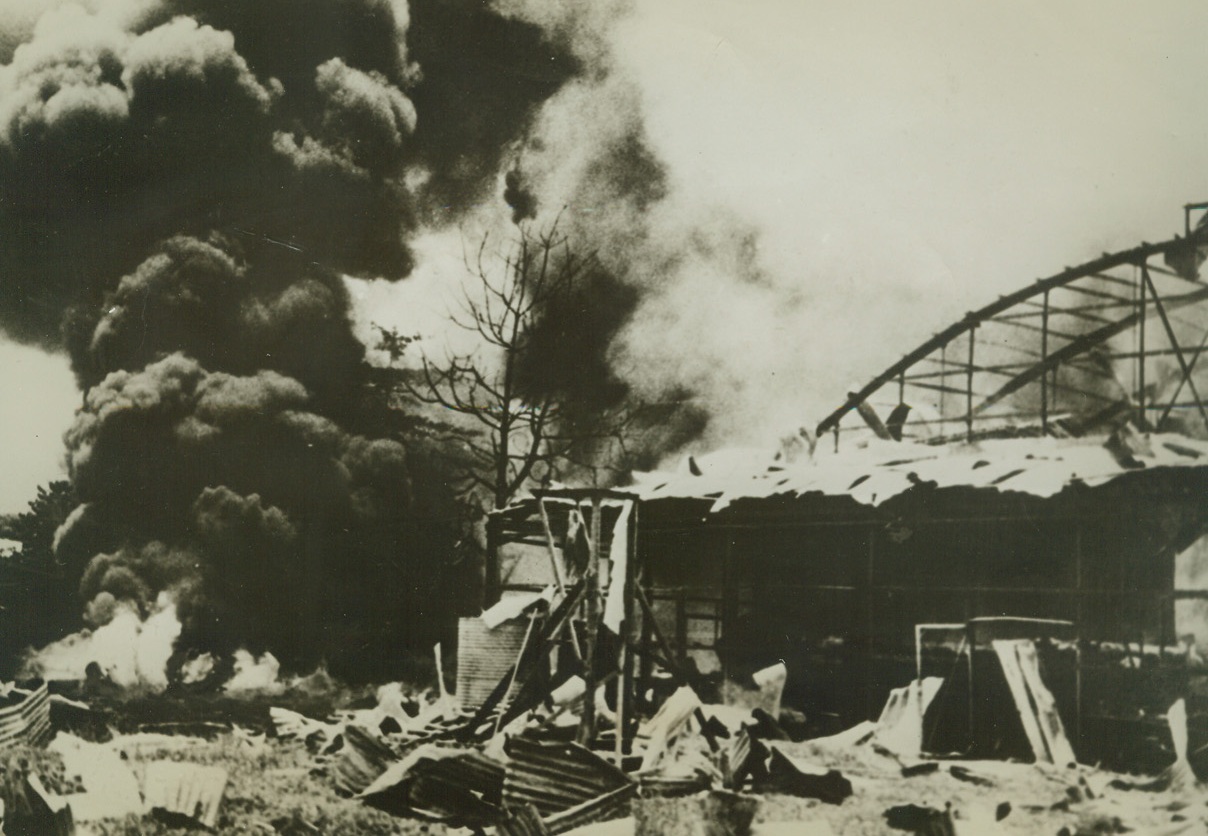
In the Path of Conquest, 4/6/1942. Salamaua, New Guinea --- As the Japanese pat of conquest extends southward to Australian waters, a hangar at Salamaua, New Guinea, burns during a Japanese air raid. This is one of the first pictures to reach the United States of Japanese destruction on the island. Credit line (ACME);
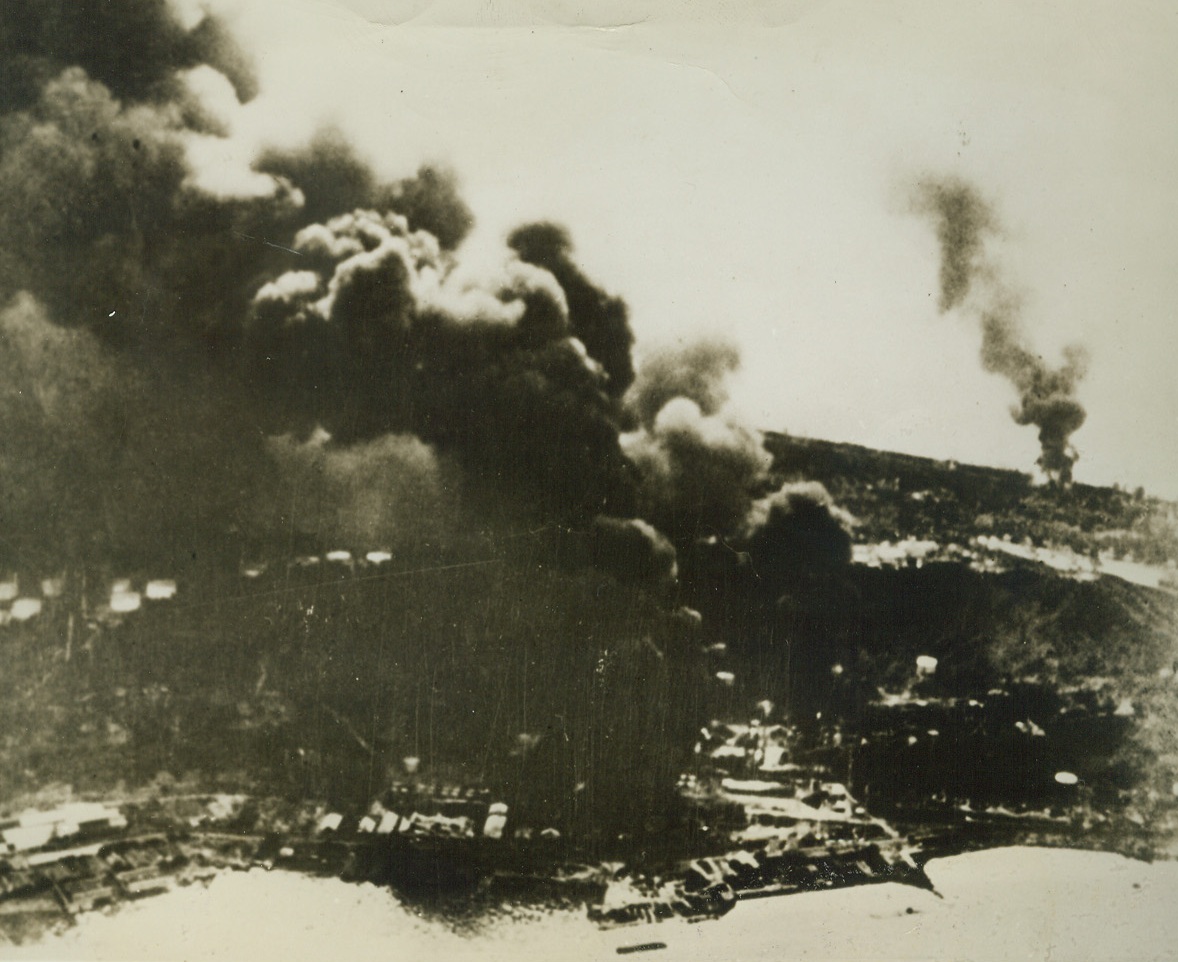
No Title. 4/6/1942. This is the first photo to reach the United States of the destruction of the valuable Balikpapan oil fields by the Dutch, to keep Japanese invaders from capturing the oil for their own use. Heavy clouds of black smoke mark the end of the second largest oil center in the East. Inhabitants set the fire Feb, 25th, in spite of Japanese threats to show no mercy to the inhabitants of this East coast burned center, if the oil was destroyed. Credit line (ACME);
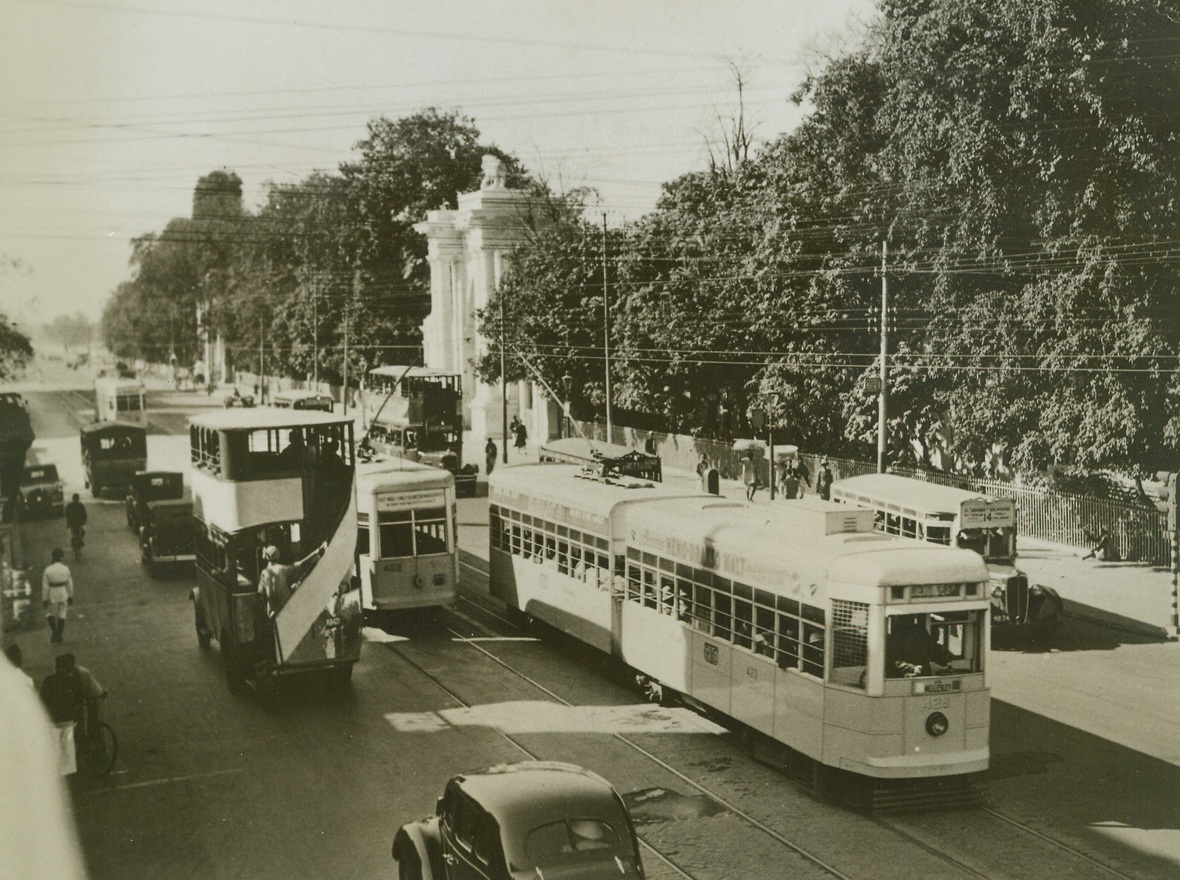
Indian city endangered by new Jap landing at Akyab, 4/2/1942. Calcutta, India – This Indian city is now in danger of extensive aerial bombardment by Jap planes, since it was announced, April 2nd, that thousands of Japs have landed at the Burmese port of Akyab, only 350 air miles across the bay of Bengal from Calcutta. Here, modern transportation in Calcutta, is shown. Credit line (ACME);
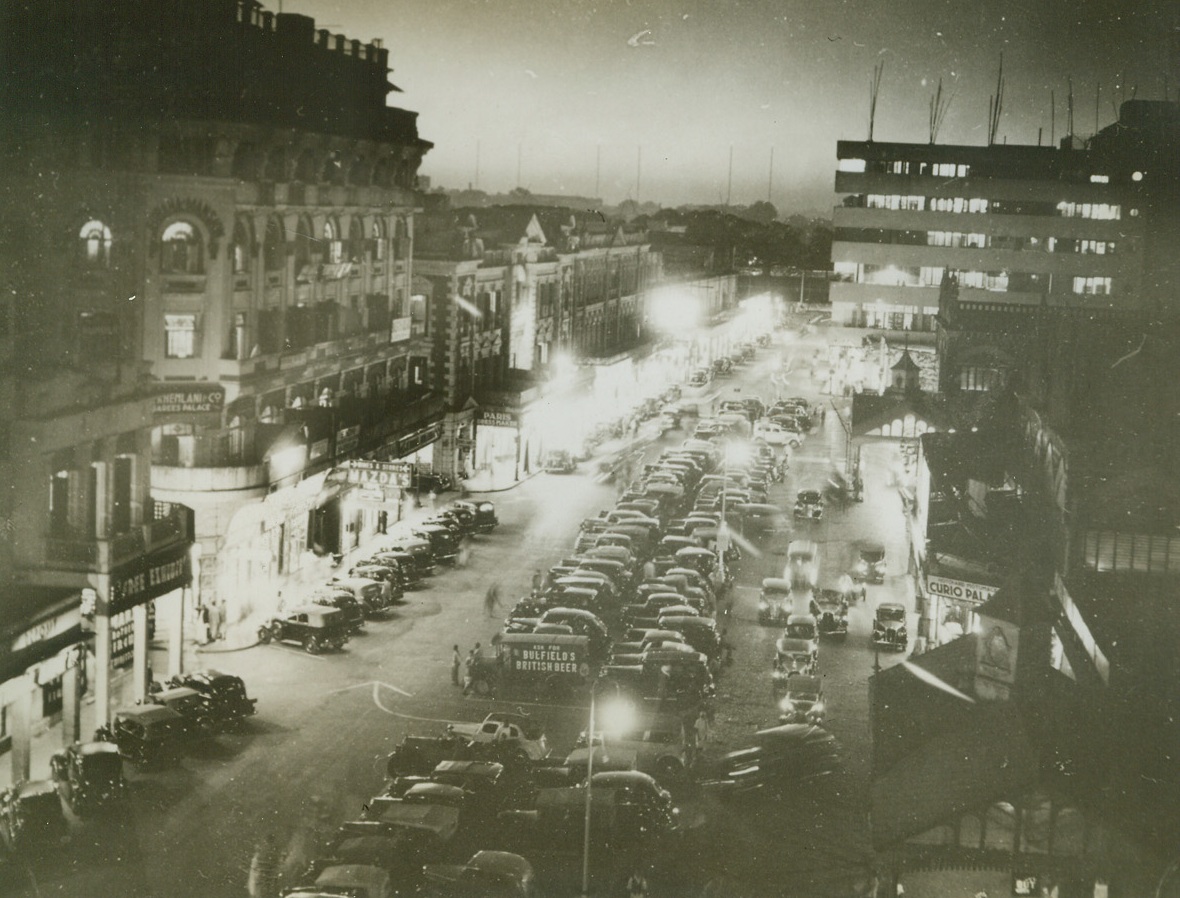
Jap Landing at Akyab Imperils Calcutta, 4/2/1942. Calcutta, India – The announcement, April 2nd, that thousands of Japanese troops had been landed at the Burmese port of Akyab, only 350 air miles from Calcutta, places the latter city in imminent peril of heavy aerial bombardment by the Japs, using Akyab as a base. Here, is a night scene in Lindsay Street, Calcutta. Cars are shown parked outside the Hogg market. Credit line (ACME);
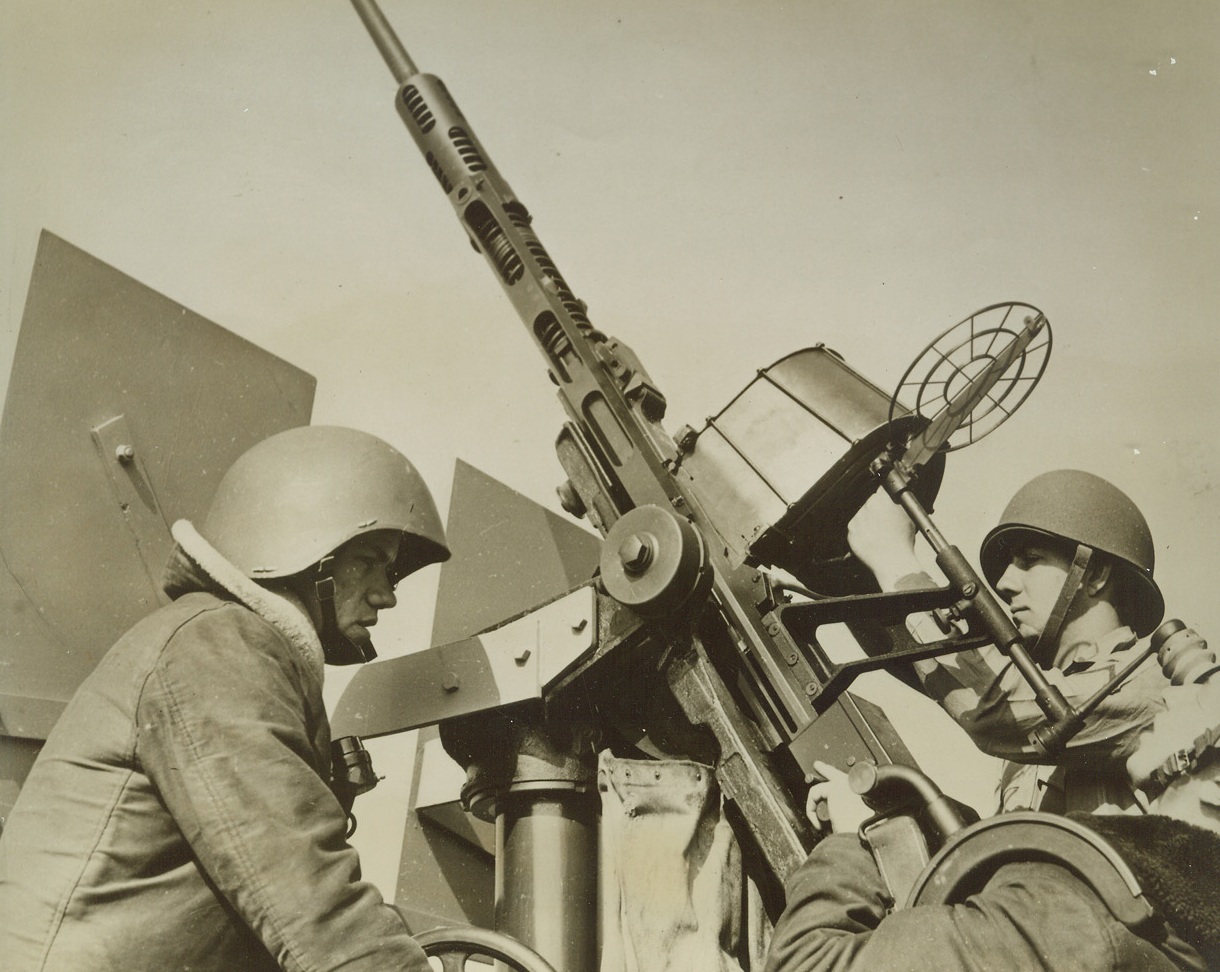
“Ack-Ack” Gunners in the Atlantic, 4/18/1942. At Sea—Anti-aircraft gunners of a warship of the U.S. Atlantic fleet are shown at their stations as the fleet goes about its business of keeping the sea lanes of the Atlantic open for United Nations shipping. This job is as vital as any of our war effort, for supplies must reach our Allies in Britain and Russia—and they are doing so. (Approved by U.S. Navy) Credit: ACME.;
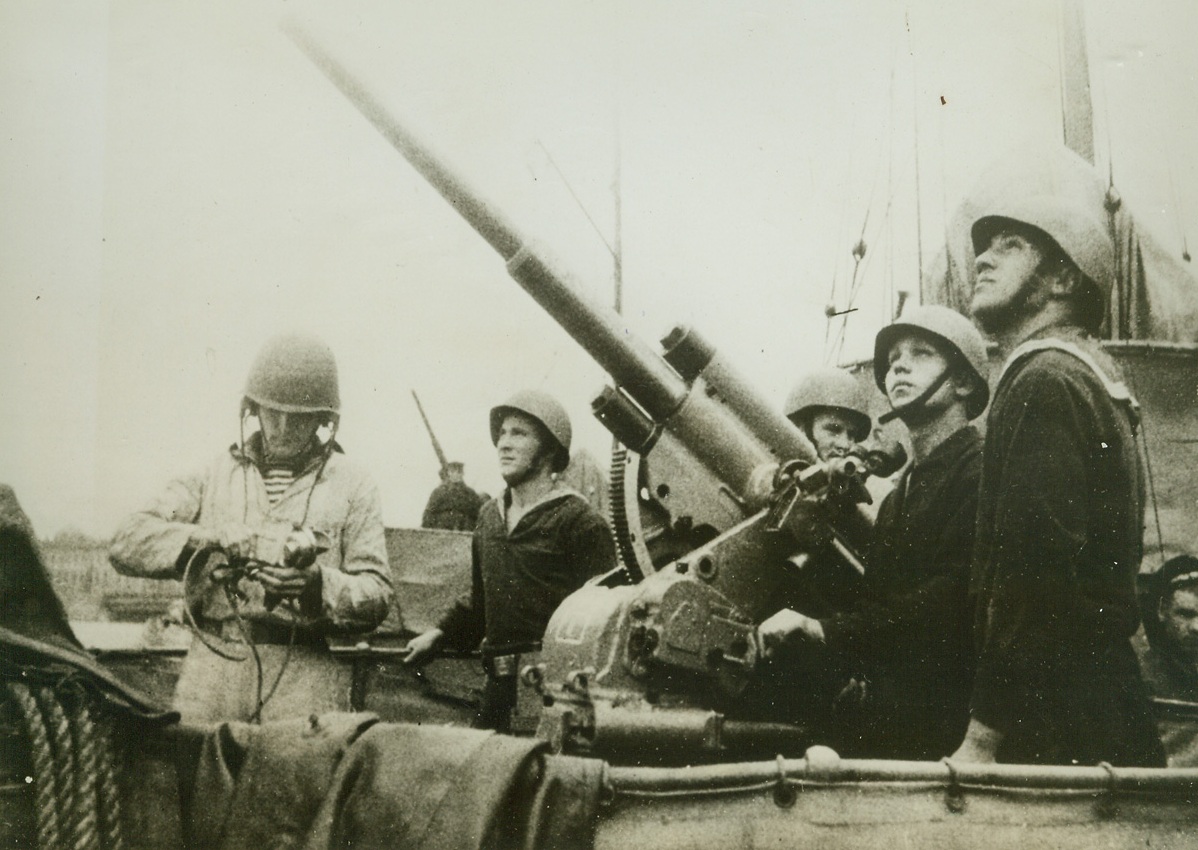
In Defense of Leningrad, 4/17/1942. Leningrad, Russia—Soviet anti-aircraft gunners of a Soviet warship at Leningrad stand ready to repulse attacks by German aircraft on the city as might Russian attacks farther north and south attempt to relieve the enemy siege of the city. Passed by censor. Credit: ACME.;
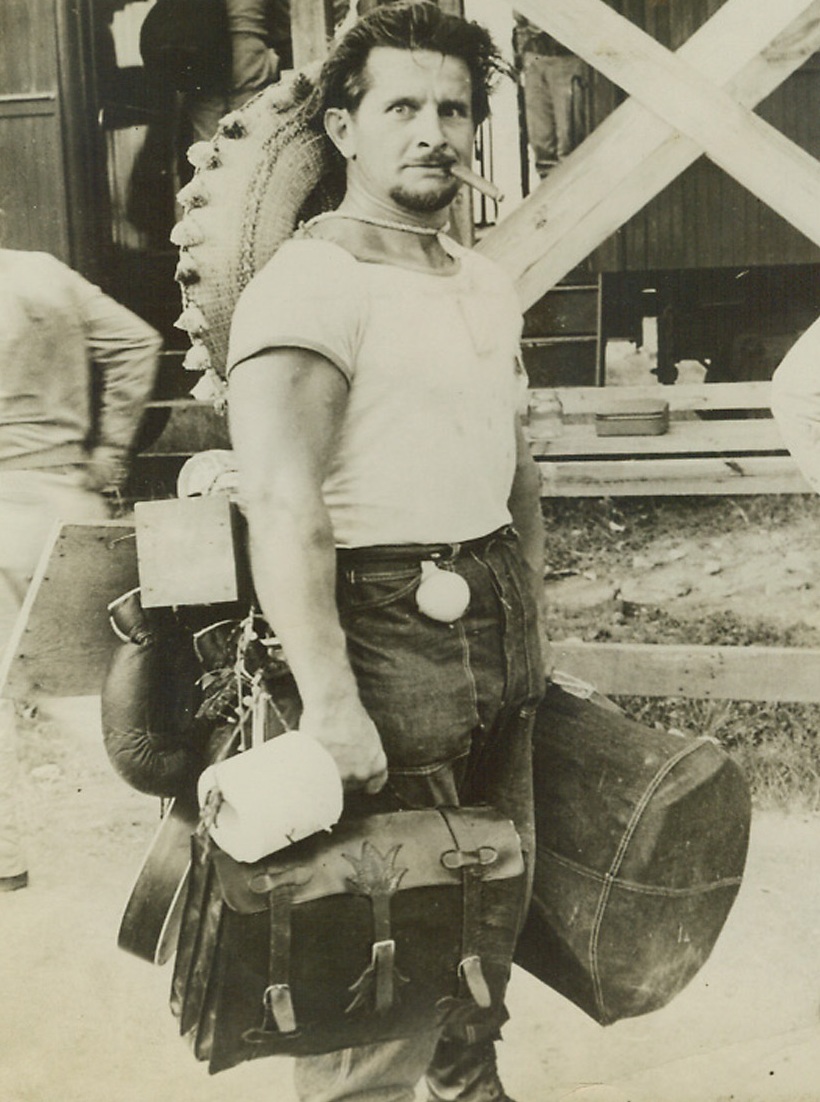
Enemy Aliens Shipped From Panama Canal Zone, 4/7/1942. Otto, an enemy alien, is equipped for “any emergency” as he leaves his internment camp in the Canal Zone. As No. 1 man of the German faction interned, he was their unofficial mayor, and directed all activities of the group in confinement. He was evacuated along with many other alien enemies to camps in the United States. Utmost secrecy prevailed in evacuation of the group to protect them from their own submarines. (Passed by censor).;
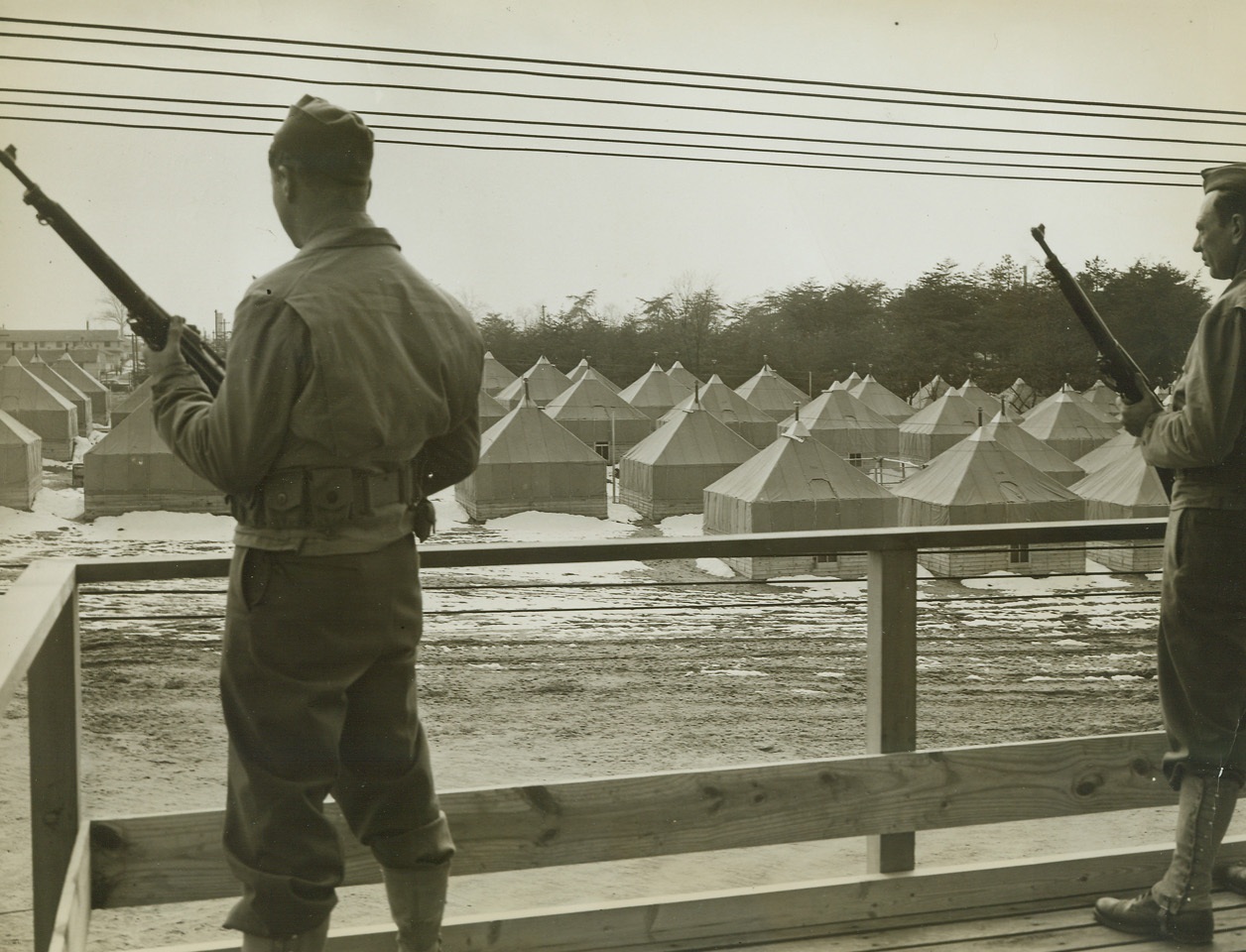
No Title. 4/2/1942. Several hundred German, Italian and Japanese nationals have been interned at Fort Meade...They live in tents of the same type used by United States troops. They dine on the same fare. The different nationalities are seperated within a high-wire enclosure. No visiting among groups is allowed. Site of the internment camp was formerly a training center for reserve officers. Photo shows a section of the camp as seen from the top of a guard house.;
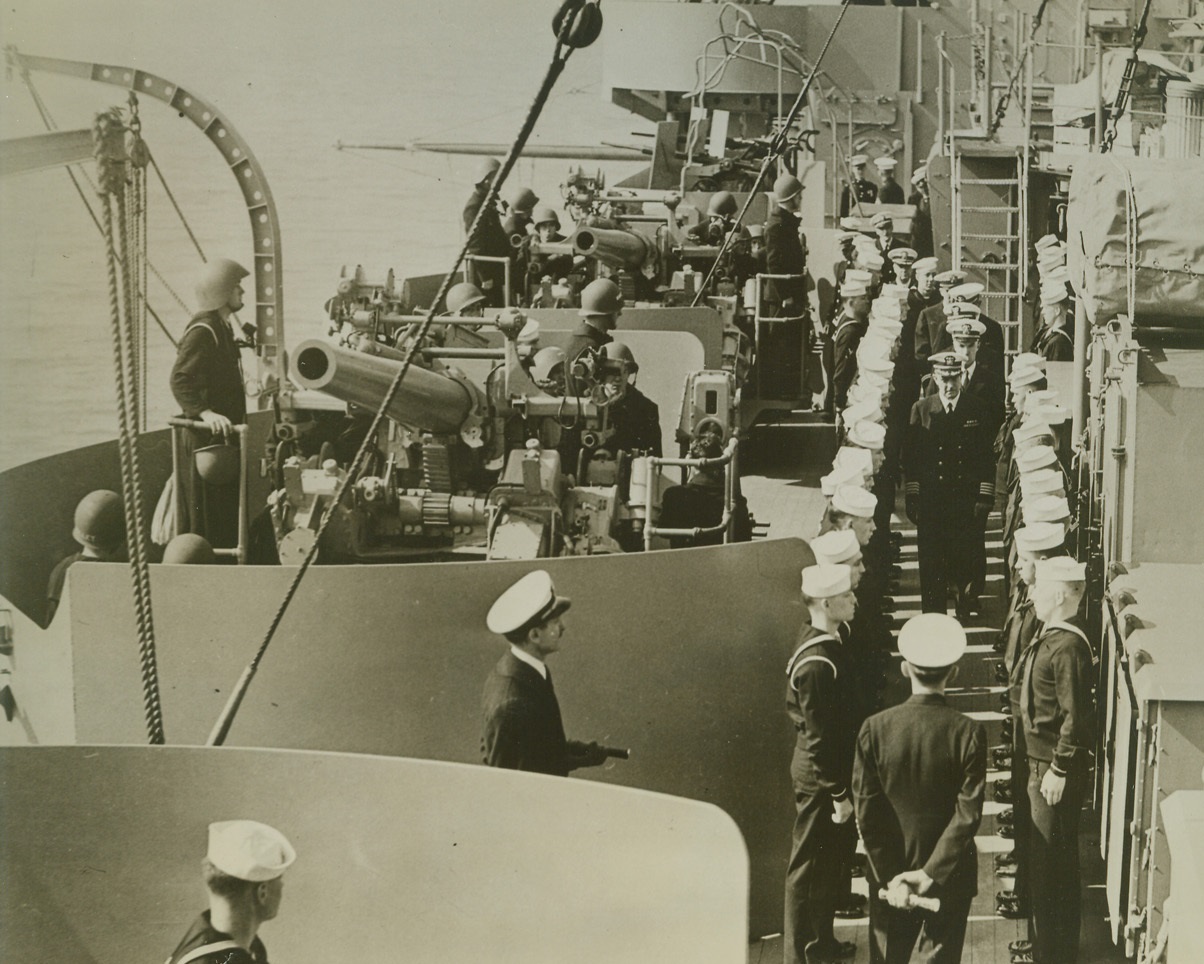
On Patrol With the Atlantic Fleet, 4/18/1942. At Sea—Early morning abroad one of the fighting ships of the U.S. Atlantic Fleet as it makes its sweep of the Atlantic, keeping ocean roads to our Allies in Europe clear of Marine gangsters. Here you see one party of gobs lined up for inspection by the skipper while others man the guns, ready to do business at a moment’s notice. Approved by U.S. Navy Credit: ACME.;
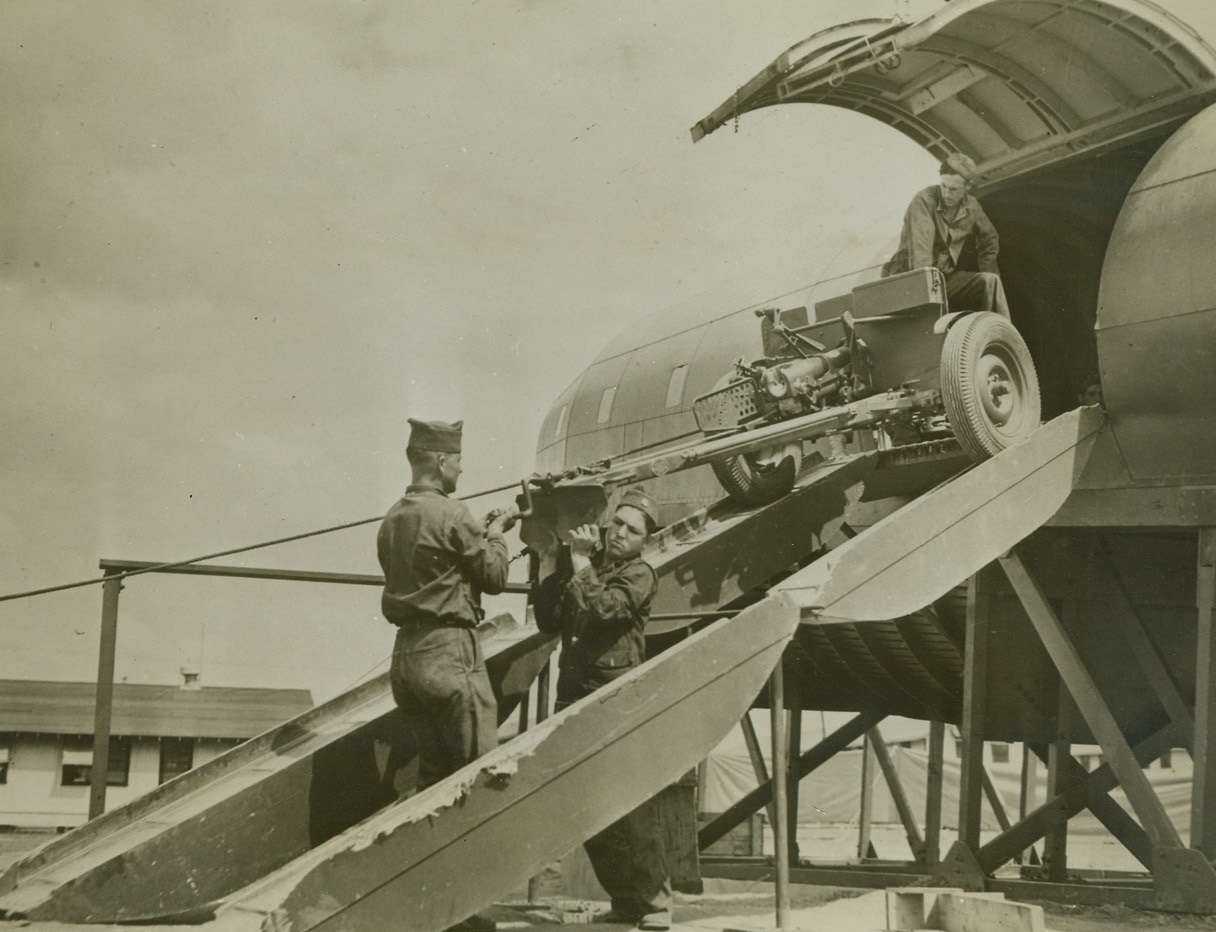
U.S. Army Trains Its Infantry, 4/20/1942. Keeping abreast of the speedy development of the modern science of warfare, the U.S. Army is gradually developing the means of transporting whole armies and their equipment--when necessary--by air. At a training camp “somewhere in the United States,” airborne infantry is being trained to move fast and far with all their equipment--cars, guns and men--as self-contained units capable of landing, attacking and holding important objectives. Practicing during their preliminary phases on replicas of giant air transports called “mockups,” they later advance to training with real planes. Here, a gun crew unloads its anti-tank gun after theoretically landing at its objective. Credit: U.S. Army Signal Corps photo from ACME;
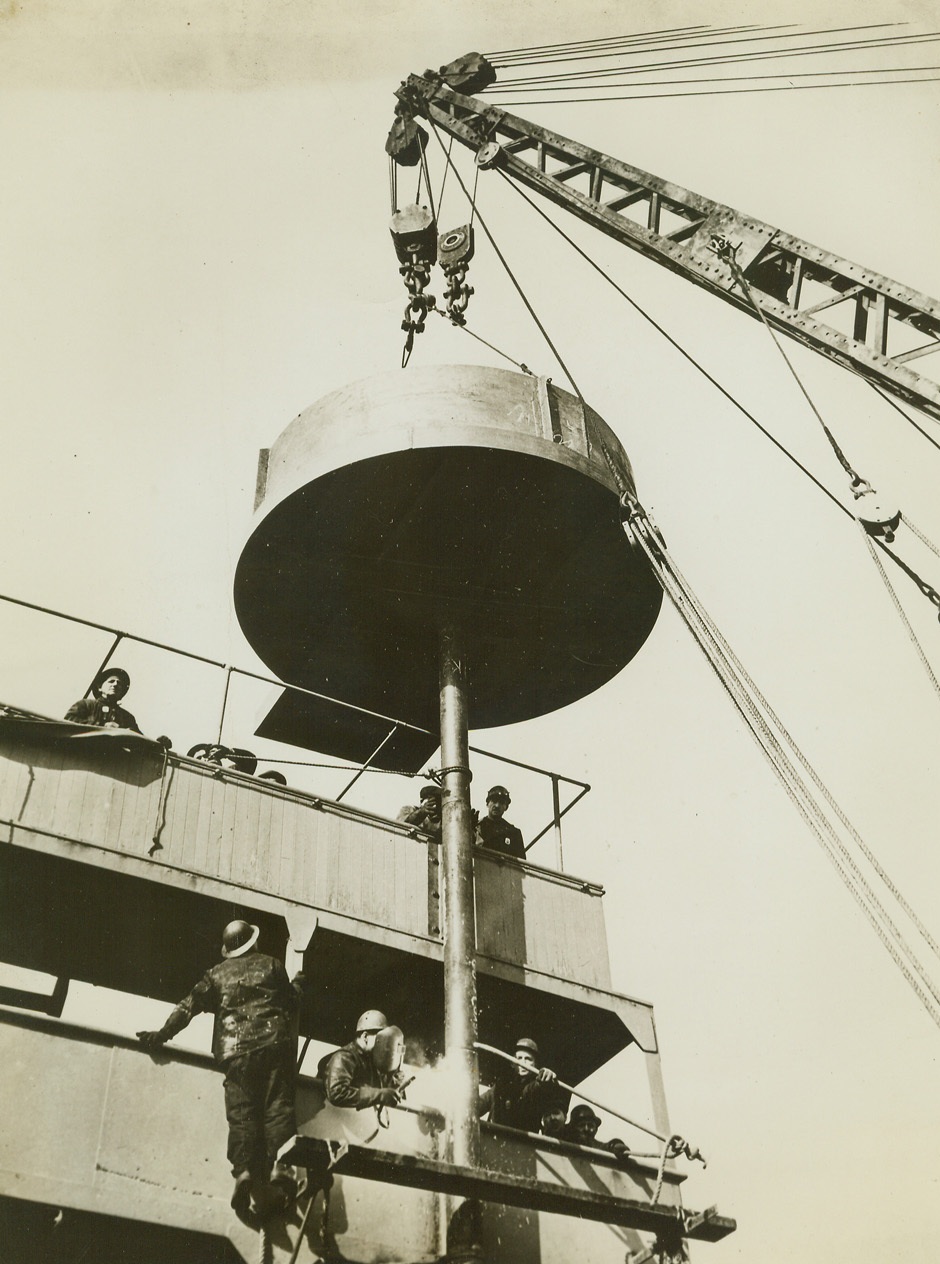
Navy Speeds Arming of Merchantmen, 4/9/1942. Held in place by a powerful crane, a machine gun nest is shown as it is welded to the superstructure of a Merchantman. Credit: Official Navy photo from ACME;
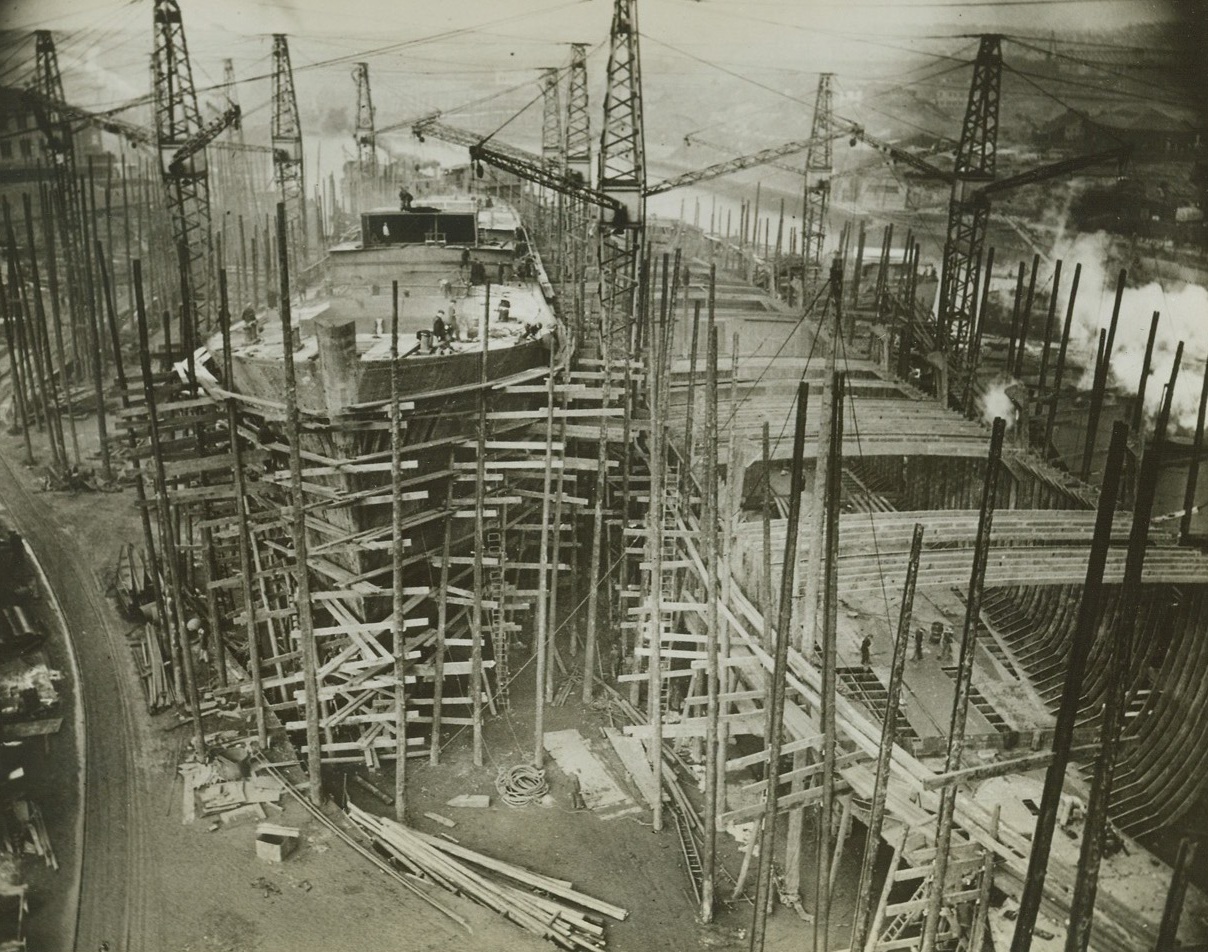
BUILDING SHIPS FOR THE BRITISH MERCHANT NAVY, 4/2/1942. AN ENGLISH PORT – British shipyards are launching ships with all possible speed; a 10,000-tower now gets its last coat of paint only 5 ½ months after the reel laying. Widespread use of pre-fabrication has helped this speed-up and welding instead of riveting saves time and steel. Here, is a view of two ships under construction in a shipyard at “an English port”.Credit: Acme;
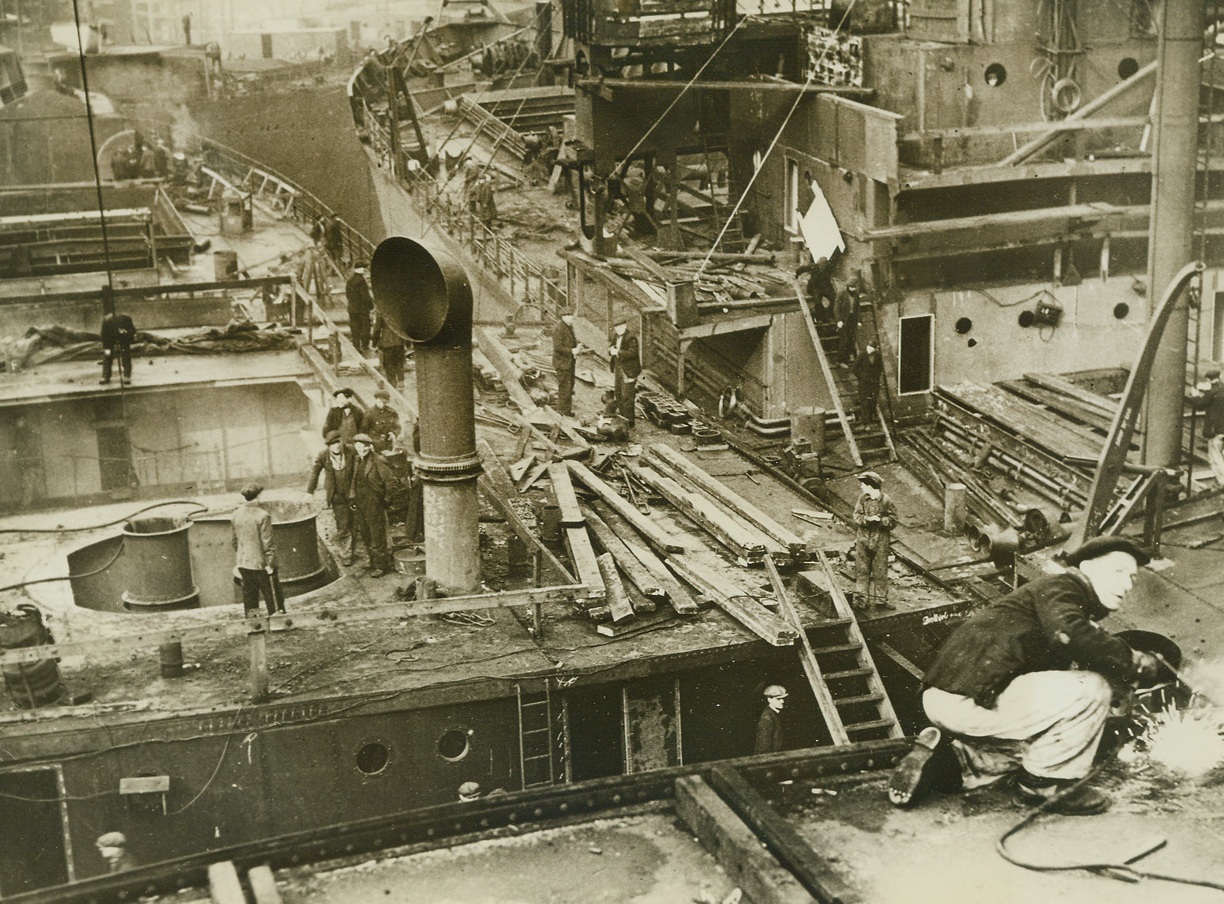
BUILDING SHIPS FOR THE BRITISH MERCHANT NAVY, 4/2/1942. AN ENGLISH PORT – British shipyards are launching ships with all possible speed; a 10,000-tonner now gets its last coat of paint only five and one-half months after the keel laying. Widespread use of pre-fabrication has helped this speed-up and welding instead of riveting saves time and steel. Here, work is shown in progress on the decks of almost completed ships at a shipyard at “an English port”.Credit: Acme;
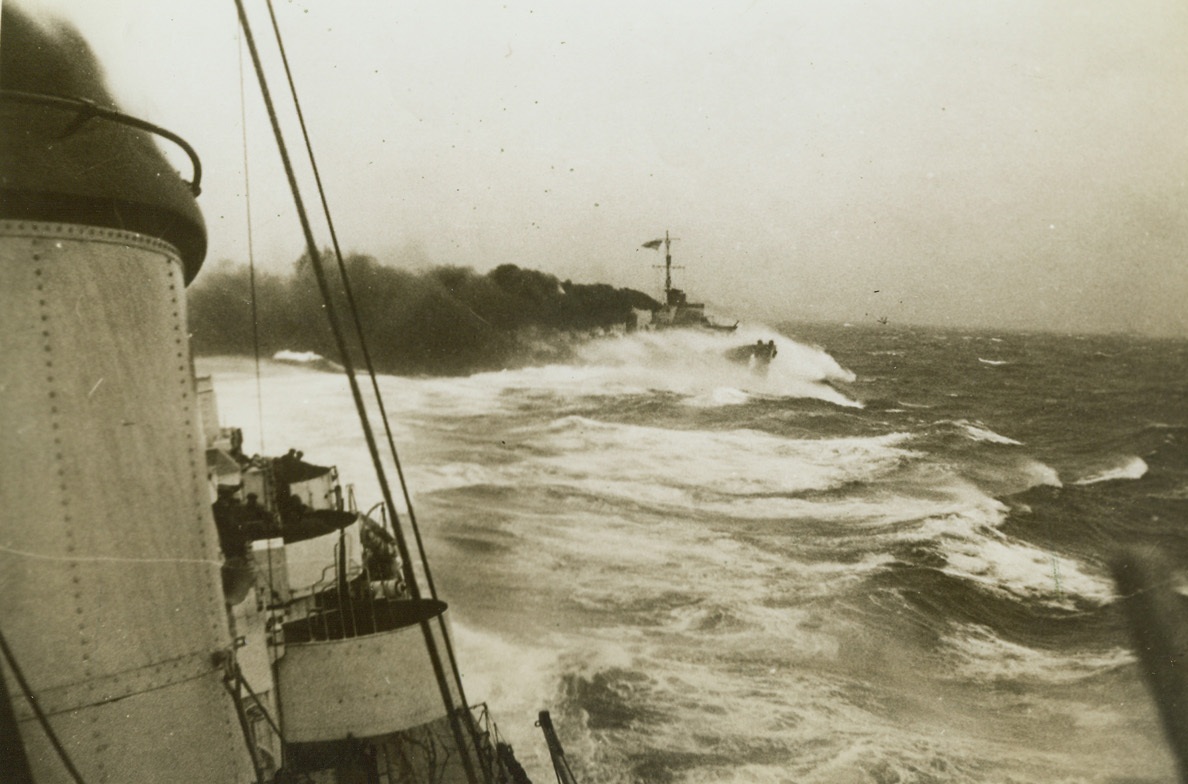
SMOKE SCREEN, 4/8/1942. A British destroyer lays down a heavy smoke screen to cover a Mediterranean convoy and in the same maneuver follows through to make a torpedo attack on the Italian warship Littorio during a Mediterranean engagement near Alta which occurred on March 22nd when a heavy Italian sea force attacked a British warship-escorted convoy.Credit: Acme;
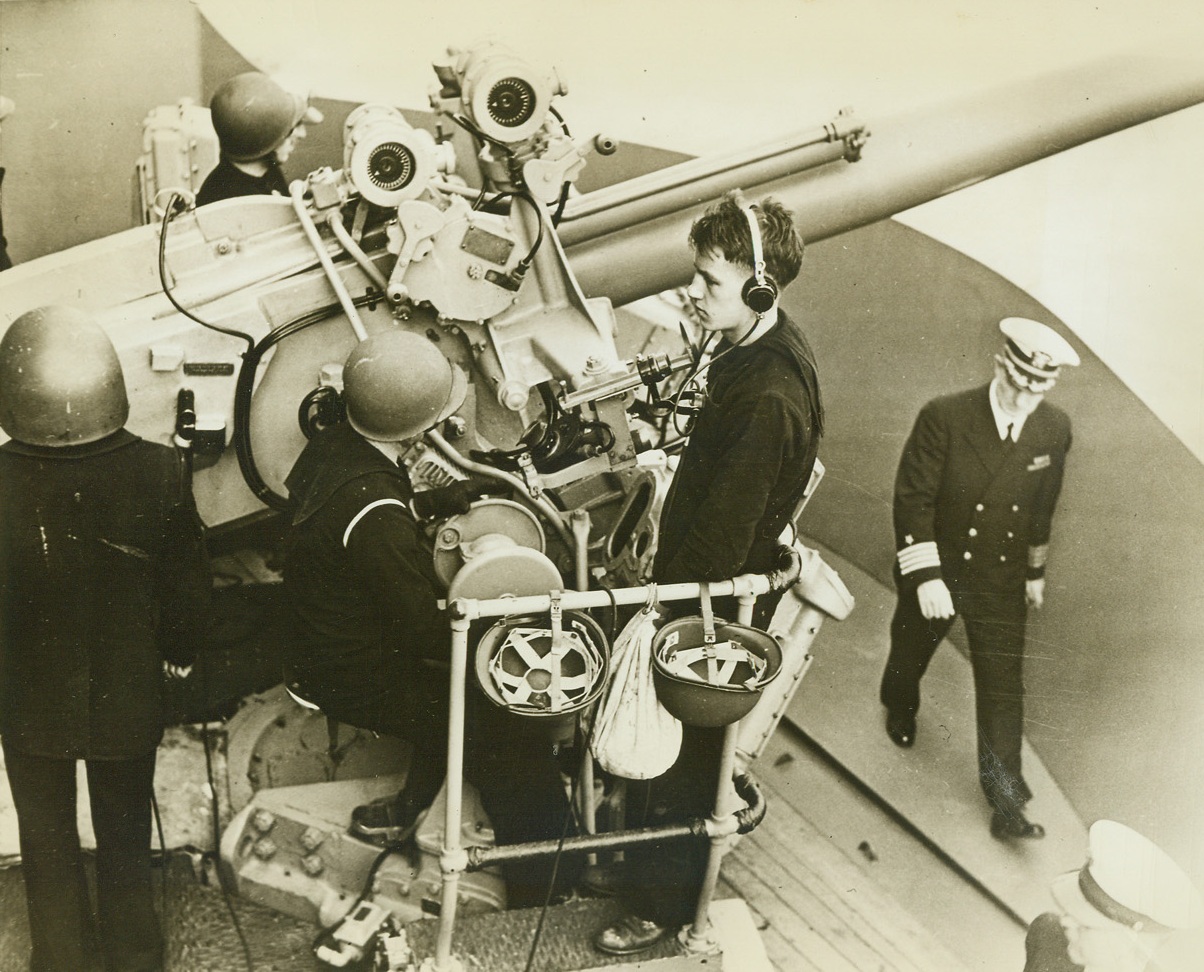
“BATTLE STATIONS” WITH ATLANTIC FLEET, 4/18/1942. AT SEA – There are no holidays aboard warships of the U.S. Atlantic fleet when it is at sea and doing its job of keeping the ocean highways open to our allies in Britain and Russia. The men are constantly at battle stations, for they are in the front line. This gun crew is ready to open fire at a moment’s notice. Sailor with earphones gets his orders from the fire control tower. Credit: Acme;
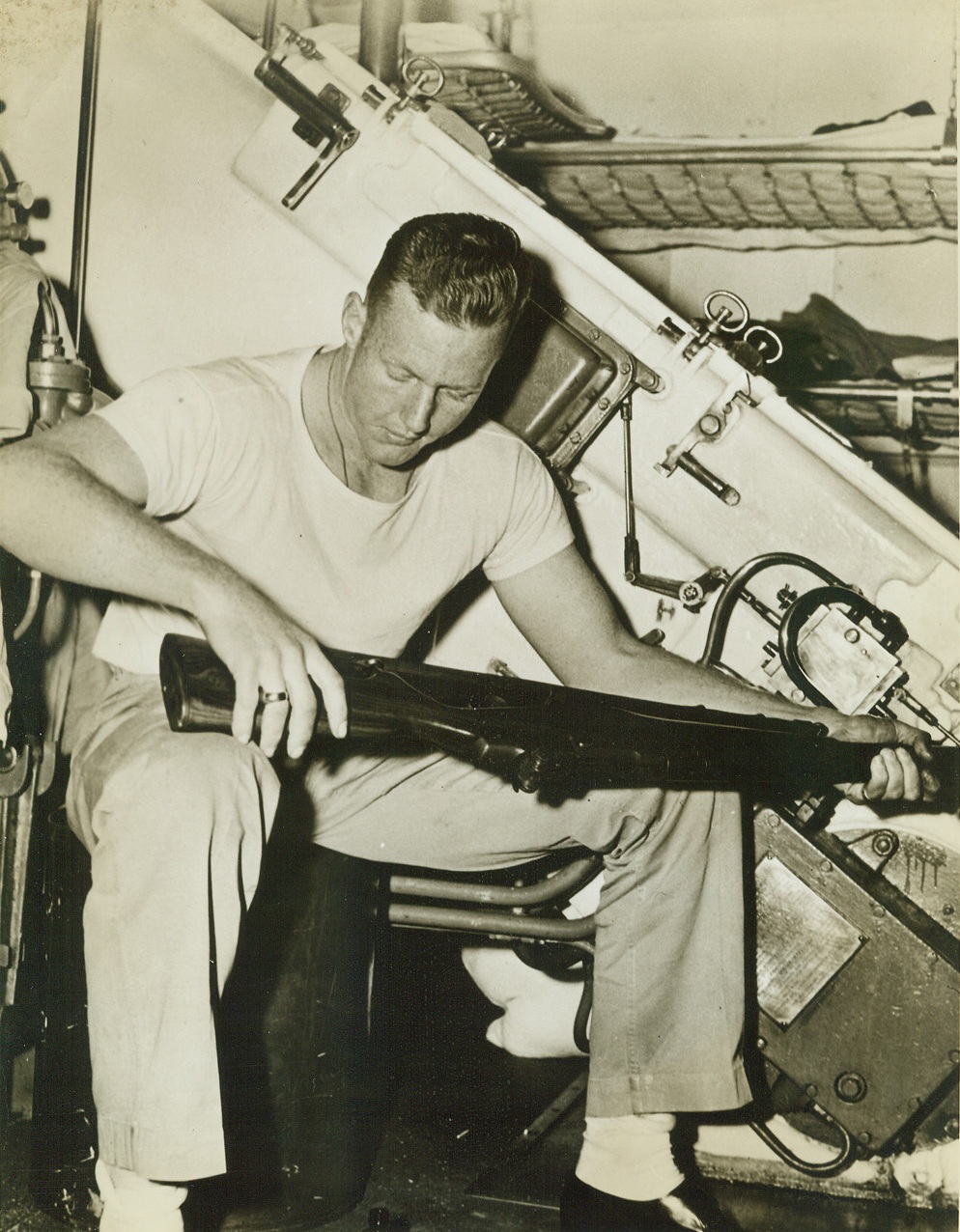
A Marine and His Pal at Sea with Fleet, 4/18/1942. At Sea – If every husband gave his wife the loving care that a U.S. Marine gives to his rifle—there would be nary a divorce. This Leatherneck is grooming his weapon while off duty aboard one of the heavy-hitting units of the U.S. Atlantic Fleet on the ocean highways of Europe. Approved by U.S. Navy. Credit: ACME;
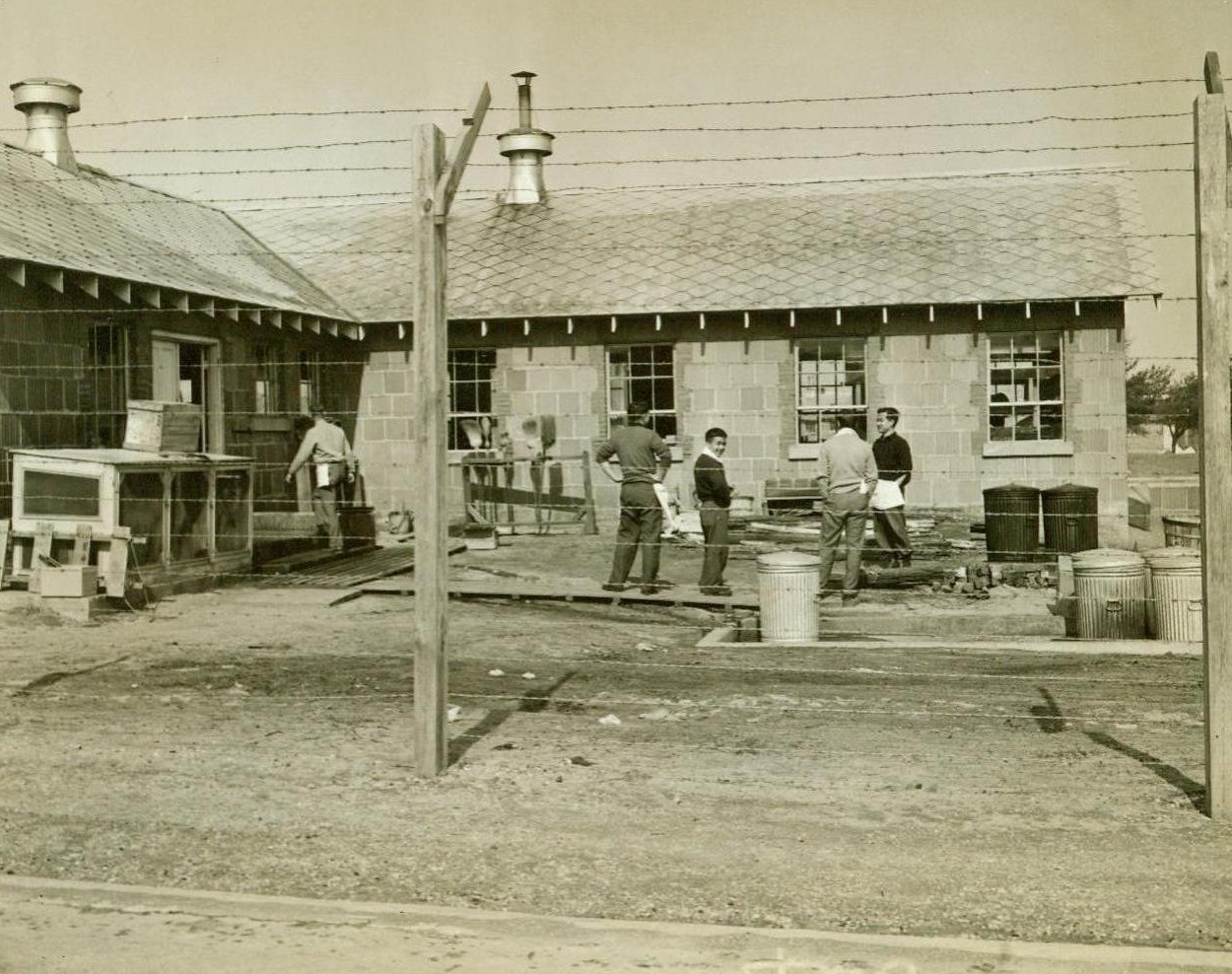
Enemy Aliens Interned At Maryland Fort, 4/2/1942. Several hundred German, Italian and Japanese nationals have been interned at Fort Meade, MD. They live in tents of the same type used by United States troops. They dine on the same fare. The different nationalities are separated within a high-wire enclosure. No visiting among groups is allowed. Site of the internment camp was formerly a training center for reserve officers. 4/2/42 (ACME);
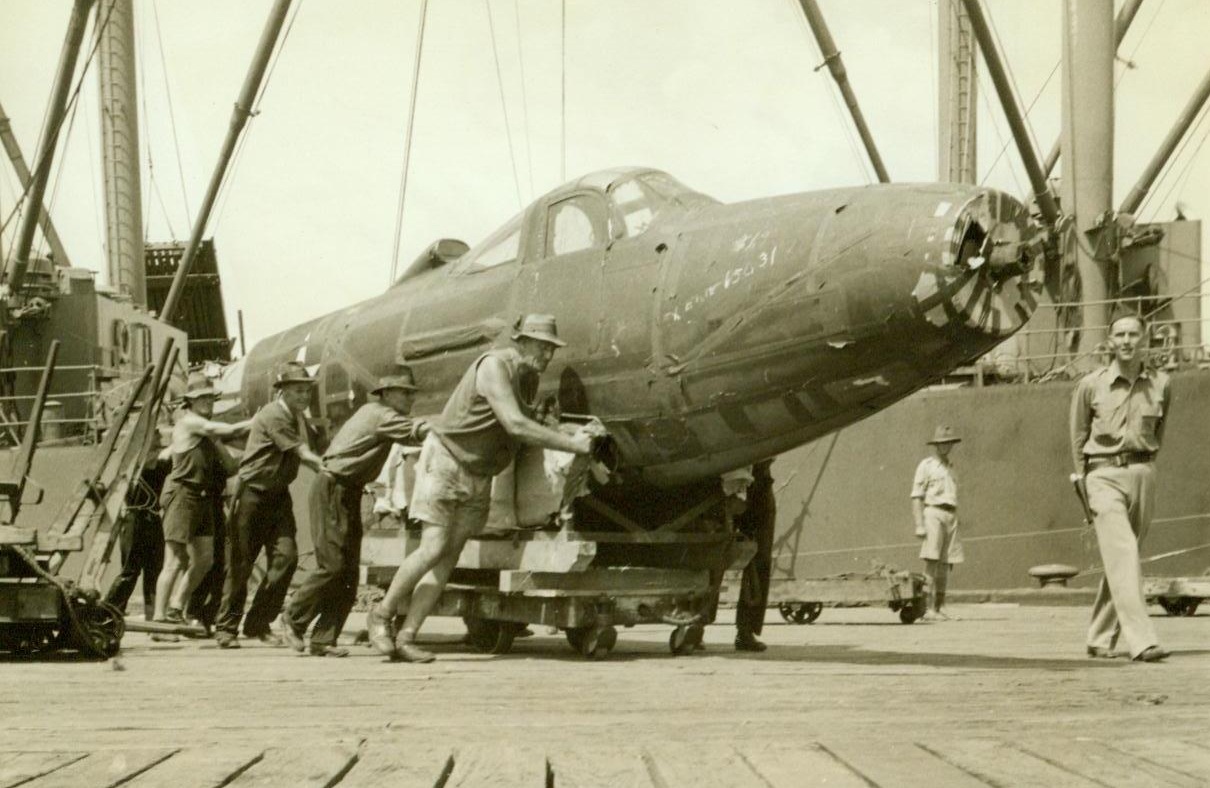
Air Defender From U.S., 4/18/1942. Australia – A deadly U.S. Aircobra fighter plane is unloaded in an Australian port from A U.S. transport which crossed the Pacific in a convoy rearing American troops and war supplies. 4/18/42 (ACME);





 Trash & Recycling
Trash & Recycling
 Online Payments
Online Payments
 City Documents
City Documents
 Parks
Parks
 Traffic Court
Traffic Court
 CITY PARKS
CITY PARKS
 Outdoor Recreation
Outdoor Recreation
 Volunteer
Volunteer
 Home
Home TRANSLATE
TRANSLATE
